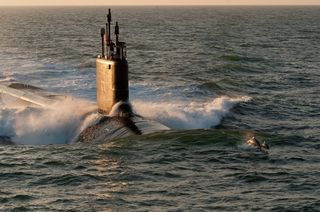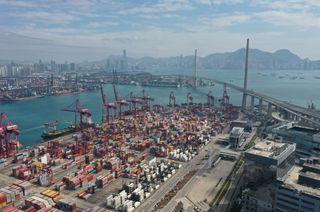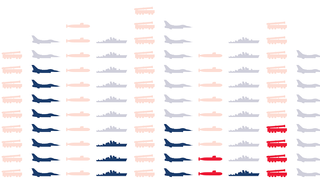Executive summary
America no longer enjoys military primacy in the Indo-Pacific and its capacity to uphold a favourable balance of power is increasingly uncertain.
- The combined effect of ongoing wars in the Middle East, budget austerity, underinvestment in advanced military capabilities and the scale of America’s liberal order-building agenda has left the US armed forces ill-prepared for great power competition in the Indo-Pacific.
- America’s 2018 National Defense Strategy aims to address this crisis of strategic insolvency by tasking the Joint Force to prepare for one great power war, rather than multiple smaller conflicts, and urging the military to prioritise requirements for deterrence vis-à-vis China.
- Chinese counter-intervention systems have undermined America’s ability to project power into the Indo-Pacific, raising the risk that China could use limited force to achieve a fait accompli victory before America can respond; and challenging US security guarantees in the process.
- For America, denying this kind of aggression places a premium on advanced military assets, enhanced posture arrangements, new operational concepts and other costly changes.
- While the Pentagon is trying to focus on these challenges, an outdated superpower mindset in the foreign policy establishment is likely to limit Washington’s ability to scale back other global commitments or make the strategic trade-offs required to succeed in the Indo-Pacific.
Over the next decade, the US defence budget is unlikely to meet the needs of the National Defense Strategy owing to a combination of political, fiscal and internal pressures.
- The US defence budget has been subjected to nearly a decade of delayed and unpredictable funding. Repeated failures by Congress to pass regular and sustained budgets has hindered the Pentagon’s ability to effectively allocate resources and plan over the long term.
- Growing partisanship and ideological polarisation — within and between both major parties in Congress — will make consensus on federal spending priorities hard to achieve. Lawmakers are likely to continue reaching political compromises over America’s national defence at the expense of its strategic objectives.
- America faces growing deficits and rising levels of public debt; and political action to rectify these challenges has so far been sluggish. If current trends persist, a shrinking portion of the federal budget will be available for defence, constraining budget top lines into the future.
- Above-inflation growth in key accounts within the defence budget — such as operations and maintenance — will leave the Pentagon with fewer resources to grow the military and acquire new weapons systems. Every year it becomes more expensive to maintain the same sized military.
America has an atrophying force that is not sufficiently ready, equipped or postured for great power competition in the Indo-Pacific — a challenge it is working hard to address.
- Twenty years of near-continuous combat and budget instability has eroded the readiness of key elements in the US Air Force, Navy, Army and Marine Corps. Military accidents have risen, aging equipment is being used beyond its lifespan and training has been cut.
- Some readiness levels across the Joint Force are improving, but structural challenges remain. Military platforms built in the 1980s are becoming harder and more costly to maintain; while many systems designed for great power conflict were curtailed in the 2000s to make way for the force requirements of Middle Eastern wars — leading to stretched capacity and overuse.
- The military is beginning to field and experiment with next-generation capabilities. But the deferment or cancellation of new weapons programs over the last few decades has created a backlog of simultaneous modernisation priorities that will likely outstrip budget capacity.
- Many US and allied operating bases in the Indo-Pacific are exposed to possible Chinese missile attack and lack hardened infrastructure. Forward deployed munitions and supplies are not set to wartime requirements and, concerningly, America’s logistics capability has steeply declined.
- New operational concepts and novel capabilities are being tested in the Indo-Pacific with an eye towards denying and blunting Chinese aggression. Some services, like the Marine Corps, plan extensive reforms away from counterinsurgency and towards sea control and denial.
A strategy of collective defence is fast becoming necessary as a way of offsetting shortfalls in America’s regional military power and holding the line against rising Chinese strength. To advance this approach, Australia should:
- Pursue capability aggregation and collective deterrence with capable regional allies and partners, including the United States and Japan.
- Reform US-Australia alliance coordination mechanisms to focus on strengthening regional deterrence objectives.
- Rebalance Australian defence resources from the Middle East to the Indo-Pacific.
- Establish new, and expand existing, high-end military exercises with allies and partners to develop and demonstrate new operational concepts for Indo-Pacific contingencies.
- Acquire robust land-based strike and denial capabilities.
- Improve regional posture, infrastructure and networked logistics, including in northern Australia.
- Increase stockpiles and create sovereign capabilities in the storage and production of precision munitions, fuel and other materiel necessary for sustained high-end conflict.
- Establish an Indo-Pacific Security Workshop to drive US-allied joint operational concept development.
- Advance joint experimental research and development projects aimed at improving the cost-capability curve.
Introduction
America’s defence strategy in the Indo-Pacific is in the throes of an unprecedented crisis. It is, at its core, a crisis born of the misalignment between Washington’s strategic ends and its available means. Faced with an increasingly contested regional security landscape and with limited defence resources at its disposal, the United States military is no longer assured of its ability to single-handedly uphold a favourable balance of power in the Indo-Pacific. China, by contrast, is growing ever more capable of challenging the regional order by force as a result of its large-scale investment in advanced military systems. Although the past 18 months have seen renewed efforts by the US Department of Defense to prioritise the requirements for great power competition with China — a key objective of America’s 2018 National Defense Strategy (NDS) — Washington has so far been unable or unwilling to sufficiently focus its armed forces on this task or deliver a defence spending plan that fits the scope of its global strategy. The result is an increasingly worrying mismatch between US strategy and resources that jeopardises the future stability of the Indo-Pacific region.
The drivers of this crisis are multi-faceted and likely to persist. At the strategic level, Washington’s commitment to an expansive liberal-order building agenda — including nearly two decades of counterinsurgency wars in the Middle East — has dangerously overstretched its defence resources. This has left the US armed forces ill-prepared for the kind of high-intensity deterrence and warfighting tasks that would characterise a confrontation with China. While the Pentagon is trying to refocus on preparations for future great power wars, an outdated superpower mindset within Washington’s foreign policy establishment continues to limit America’s ability to scale back its other global commitments or make the hard strategic and military trade-offs required to prioritise the Indo-Pacific.
An increasingly worrying mismatch between America’s strategy and resources jeopardises the future stability of the Indo-Pacific region.
This problem is being compounded by developments in the regional military balance. Having studied the American way of war — premised on power projection and all-domain military dominance — China has deployed a formidable array of precision missiles and other counter-intervention systems to undercut America’s military primacy. By making it difficult for US forces to operate within range of these weapons, Beijing could quickly use limited force to achieve a fait accompli victory — particularly around Taiwan, the Japanese archipelago or maritime Southeast Asia — before America can respond, sowing doubt about Washington’s security guarantees in the process. This has obliged the Pentagon to focus on rebuilding the conventional military capabilities required to deny Chinese aggression in the first place, placing a premium on sophisticated air and maritime assets, survivable logistics and communications, new stocks of munitions and other costly changes.
At the domestic political level, meanwhile, Congress has struggled to deliver annual defence budgets commensurate with the ever-expanding demands of America’s global strategy. The impact of the Budget Control Act’s legislative caps on defence spending over the past decade, coupled with repeated funding delays and budgetary uncertainty, has hobbled America’s ability to effectively respond to a deteriorating strategic landscape in the Indo-Pacific. Growing polarisation between Republicans and Democrats over national spending priorities, coupled with looming fiscal challenges, is likely to impede the political consensus required to achieve sufficient real growth in defence expenditure to implement the National Defense Strategy. At the same time, above-inflation growth in key accounts within the defence budget will leave the Pentagon with fewer resources to grow the military and acquire new weapons systems.
All of this has resulted in an atrophying force that is not sufficiently ready, equipped or postured to fulfil a strategy of conventional deterrence by denial in the Indo-Pacific. Indeed, the combination of two decades of near-continuous combat operations, budget dysfunction, aging equipment, and the rising cost of advanced military hardware has severely impacted the quality and quantity of America’s high-end armed forces. This has produced an accumulation of readiness problems and deferred modernisation priorities that must now be simultaneously addressed, placing additional strain on a defence budget that has only recently started to recover from a long period of austerity. While America’s military services have started to implement much-needed changes to their capabilities, posture and operational concepts to bolster conventional deterrence vis-à-vis China, it is far from clear that the Pentagon will have the budgetary capacity or strategic focus to deliver these in a robust and timely way.
This is not to say that America is becoming a paper tiger. Washington still presides over the world’s largest and most sophisticated armed forces; and is likely to continue to supply the central elements of any military counterweight to China in the Indo-Pacific. But it does mean that the United States’ longstanding ability to uphold a favourable regional balance of power by itself faces mounting and ultimately insurmountable challenges.
Australia should be deeply concerned about the state of America’s armed forces and strategic predicament in the Indo-Pacific. In order to realise shared defence objectives in the face of these challenges, Canberra would be wise to increase security cooperation with Washington and other like-minded partners to advance a strategy of collective regional defence. Such a strategy would see capable middle powers — like Australia and Japan — aggregate defence capabilities to offset shortfalls in America’s regional military power and hold the line against Chinese adventurism. This kind of collective action is not without risks and must be conducted prudently, including by remaining ever vigilant about America’s capacity and willingness to underwrite a regional balancing coalition. But as Australia’s freedom of action and ability to evade military coercion ultimately depend on the preservation of a stable strategic order, contributing to collective deterrence in the Indo-Pacific is the best way for Canberra to assist in averting a deeper crisis.
Part 1: Strategic challenges and overstretch
America’s military primacy in the Indo-Pacific is over and its capacity to maintain a favourable balance of power is increasingly uncertain. This is the stark reality facing US defence strategy today. After nearly two decades of costly distraction in the Middle East, the United States is struggling to meet the demands of great power competition with China and faces the uncomfortable truth that its armed forces are ill-prepared to succeed.
The stakes could not be higher. Since the early 1950s, America’s position in the Indo-Pacific has rested on its ability to defeat aggression, protect a network of allies and preserve a strategic order in which no single nation dominates. But this foundation of stability is now under strain. China’s military is increasingly powerful, while America’s warfighting edge has dangerously eroded. Many now warn that the United States might fail to deter — or could even lose — a limited war with China, with devastating consequences for the region’s future strategic landscape.
Alert to these risks, the US Department of Defense is taking steps to retool the armed forces for high-end warfare and focus greater resources on the Indo-Pacific. Its core aim is to bolster the balance of power by developing new ways for the United States and its regional allies and partners to deter Chinese adventurism with conventional armed forces, even in the absence of America’s traditional all-domain military dominance. The stability of the broader regional order hinges on the success of this denial strategy.
Meeting this challenge, however, requires hard strategic choices which the United States may be unwilling or unable to make. In an era of constrained budgets and multiplying geopolitical flashpoints, prioritising great power competition with China means America’s armed forces must scale back other global responsibilities. A growing number of defence planners understand this trade-off. But political leaders and much of the foreign policy establishment remain wedded to a superpower mindset that regards America’s role in the world as defending an expansive liberal order. This mindset, if it persists, will continue to overstretch defence resources, increase future warfighting risks, and prevent the robust implementation of US military strategy in the Indo-Pacific.
American primacy and the crisis of strategic insolvency
For more than 70 years, the United States has worked to maintain its pre-eminent global position by upholding favourable balances of power in the world’s most strategically significant regions — Europe, the Indo-Pacific and the Middle East. This, at its core, has been a military enterprise.1 Although trade, diplomacy and soft power have all played key roles, America’s unrivalled capacity to project combat power abroad and outmatch its adversaries has been the ultimate guarantor of a strategic order based on the continuous pursuit of military primacy. American power has deterred and defeated military aggression by aspiring regional hegemons. It has enabled the United States to sustain a vast network of allies and partners that further enhances its strength and global reach. And, following the collapse of the Soviet Union and America’s “unipolar moment”, it has facilitated Washington’s pursuit of an ambitious liberal order-building agenda targeting rogue states, combating terrorists and policing a long list of other global dangers.2
America’s armed forces have underpinned the Indo-Pacific balance of power for much of this period. Ever since the Second World War, Washington’s “defensive perimeter” in the Western Pacific — stretching along what is now known as the First Island Chain, from Japan and the Ryukyu Islands archipelago down to Taiwan and the Philippines — served as a check on the rise of Soviet and Chinese power.3 Its five treaty alliances in the region — with Japan, South Korea, the Philippines, Thailand and Australia — along with its defence assurances over Taiwan have mostly provided for deterrence and mutual restraint between China and its neighbours. In terms of force posture, large-scale defence facilities in Hawaii, Guam and Diego Garcia, and forward operating bases in Japan, South Korea, Australia and Singapore, as well as access points in several Pacific Islands nations, have enabled Washington to sustain a robust military presence across this vast maritime region. Crucially, America’s ability to guarantee the security of regional allies and partners has served as the quid pro quo for uncontested US primacy and provided the geopolitical basis for its power projection into the region. Although there have been limits to what US power could achieve, especially during the Vietnam War and on the Korean Peninsula, America’s uncontested primacy in the Indo-Pacific has deterred major power aggression, maintained regional stability and safeguarded freedom of access to international waters and airspace.
America’s Joint Force — the combined strength of its five military services — no longer has the resources, force structure, technological edge or operational concepts to fully achieve its global commitments.
Today, none of this can be taken for granted. According to a growing number of leading voices in the US national security community, Washington is facing a crisis of “strategic insolvency” in which the ends of its global strategy now outstrip its means.4 This judgement is premised on a bleak assessment of the current state of the US armed forces. As the congressionally mandated National Defense Strategy Commission puts it: “America’s military superiority — the hard-power backbone of its global influence and national security — has eroded to a dangerous degree” making it possible that Washington “could lose the next state-versus-state war it fights”.5 Analysts at the RAND Corporation have reached similar conclusions, arguing that the military is “failing to keep pace with the modernizing forces of great power adversaries, poorly postured to meet key challenges in Europe and East Asia, and insufficiently trained and ready” for major war.6 In short, America’s Joint Force — the combined strength of its five military services — no longer has the resources, force structure, technological edge or operational concepts to fully achieve its global commitments. Its capacity to uphold favourable regional balances of power by deterring great power challengers is increasingly in doubt.
At least four inter-related factors have produced this dangerous mismatch between America’s capabilities and top strategic objectives. Most, alarmingly, are self-inflicted wounds caused by years of unstrategic behaviour by both sides of the political spectrum.
First, nearly two-decades of war in the Middle East has taken a serious toll on the Joint Force, wearing out large parts of the military and leaving it ill-prepared for great power competition. Military readiness — or, the armed forces’ preparedness for combat — has been a particularly grave problem. Owing to the high operational tempo of counterinsurgencies in Afghanistan, Iraq and Syria, in addition to the military’s other global commitments, overall readiness fell to dangerous levels as the services struggled to meet unsustainable demands for overseas deployments, maintenance and training.7 By 2017 this situation had become a crisis: Only a third of the Army’s brigade combat teams were prepared for deployment, less than half the Air Force was ready for a high-end fight against a peer adversary, the Navy was facing a self-described “readiness hole”, and 53 per cent of Naval and Marine Corp aircraft were deemed “unfit to fly”.8 Although these numbers have started to recover, their corrosive effects on the Joint Force will take time and resources to repair. As then-Chairman of the Joint Chiefs of Staff General Joseph Dunford noted in March 2019, the military “cannot undo decades of degradation in just a few years”.9
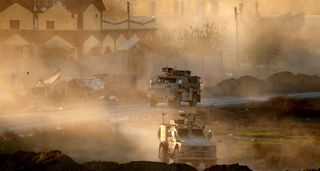
Second, while the United States was demanding ever more from its armed forces, it was simultaneously reducing its expenditure on defence and thereby compounding the strain on an already overstretched military. The root of this problem was political dysfunction within Congress.10 Following the Budget Control Act of 2011 — a congressional mechanism designed to reign in the federal deficit — real national defence spending fell from its FY2010 peak of US$798.6 billion to just US$613.3 billion in FY2017.11 This amounted to a US$550 billion loss in net buying power between 2012 and 2017.12 Making matters worse, as annual defence budgets became unpredictable in size and were not passed on time, the Pentagon was hindered in its ability to allocate resources efficiently and in a strategic way. The impact of all this exacerbated the military’s readiness crisis and was devastating for the overall size of the force. As a result, by 2016 the Army, Navy and Air Force were either at or approaching their lowest end-strength numbers since the Second World War.13
Third, the combined effect of a constrained fiscal environment and the unrelenting tempo of conflict in the Middle East has compelled the armed forces to underinvest in preparations for great power competition.14 This is a case of the urgent crowding out the important.15 Over the past two decades, critical military modernisation priorities — from the procurement of fifth generation fighters and investment in advanced technologies, to the recapitalisation of America’s nuclear triad — have been deferred or slowed by the overall squeeze on resources.16 The consequences of this failure to modernise have been dire. Not only has it contributed to the erosion of America’s technological superiority vis-à-vis peer competitors, but it has left the military with an increasingly outdated force that may be “irrelevant” for the kind of highly-contested scenarios that will characterise future wars.17 In General Dunford’s words: “Seventeen years of continuous combat and fiscal instability have affected our readiness and eroded our competitive advantage”.18 The same is true of the way that personnel training has also prioritised the near-term demands of counterinsurgency ahead of more strategically important mission sets. As Jon Kyl and Roger Zakheim, formerly with the House Armed Services Committee, have warned: The military’s sustained focus on the Middle East has created “a generation of war fighters that is ill-equipped and untrained for a conventional fight with ‘great powers’”.19
Finally, the global scope of America’s liberal order-building strategy has distracted the Pentagon from focusing on the most serious threats to US primacy: The return of China and Russia as militarily advanced great powers. This, in many ways, is the underlying driver of strategic insolvency today. Since the end of the Cold War, the expansion of American security commitments to a total of 69 countries, along with Washington’s overly ambitious democracy promotion agenda, has set the United States on an unsustainable strategic trajectory.20 Although this liberal order project appeared feasible in the 1990s, it became prohibitively expensive as the costs of military interventions from the Balkans to the Middle East stacked up, and as the diffusion of sophisticated defence technology saw more and more adversaries acquire potent counter-intervention capabilities.21
America’s capacity to enforce its vast liberal order has also correspondingly declined. Whereas the United States and its allies accounted for 80 per cent of world defence spending in 1995, today their share has fallen to just 52 per cent — leaving them less well-equipped to address an ever growing line-up of international challenges.22 As Harvard University academic Stephen Walt observes of US strategy during this period: “The available resources had shrunk, the number of opponents had grown, and still America’s global agenda kept expanding”.23 The consequences of this overstretch are now coming home to roost. Not only have the direct costs of liberal order-building been astronomical — by some estimates, the Department of Defense has spent over US$1.8 trillion on the global war on terror since 11 September 2001 for little strategic payoff — but the worldwide diffusion of American resources and attention has left the military underprepared for the return of great power competition.24 This is what the Pentagon is now working to address.
Figure 1: The scale of America’s global military presence and counterterrorism activities
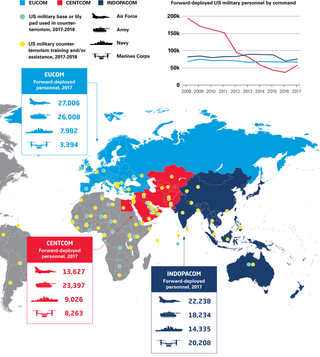
Refocusing on China and great power competition
The Department of Defense’s 2018 National Defense Strategy sounded a clarion call for prioritising great power competition and rebuilding America’s military edge. It is, in many ways, a direct attempt to address the burgeoning crisis of strategic insolvency. Heavily influenced by then-Secretary of Defense James Mattis and his strategy team, its overriding aim is to jolt the Washington security establishment out of its strategically undisciplined approach to foreign policy and defence. To this end, the NDS is explicit about the most important threats facing America, declaring that: “Inter-state strategic competition, not terrorism, is now the primary concern in US national strategy” and should be the central organising principle for the Pentagon’s efforts to emerge from “a period of strategic atrophy”.25
Its authors are extremely clear about why this grand strategic course correction is needed. As Mattis stated during the launch of the strategy: “Our competitive edge has eroded in every domain of warfare — air, land, sea, space and cyberspace — and it is continuing to erode”, particularly vis-à-vis great powers like China and Russia.26 The NDS singles out the Joint Force’s “backlog of deferred readiness, procurement and modernization requirements” as the key factor behind this worrying trendline, attributing it to “inadequate and misaligned resources” and the effects of years of conflict in the Middle East.27 To rectify all this is a major political-military challenge. Acknowledging that “America’s military has no preordained right to victory on the battlefield”, the NDS warns that policymakers will have to make “difficult choices” if the United States is to successfully refocus its armed forces on long-term strategic competition with peer adversaries.28

While the NDS lists both China and Russia as great power threats, China is portrayed as the more formidable — and is by far the most significant challenge to US interests over the long term.29 Its rising power lies behind the strategy’s overall emphasis on strengthening high-end warfighting readiness, military lethality and advanced capabilities in preparation for future contingencies. In this regard, the NDS builds on the “Rebalance to Asia” and “Third Offset Strategy” which also sought to focus defence resources on strategic competition with China, albeit with less clarity and rather limited results.30 But it goes further than previous defence strategy documents in diagnosing the challenge China poses to America’s strategic position.
Amplifying the Trump administration’s 2017 National Security Strategy, the NDS contends that China is leveraging its military modernisation as part of an “all-of-nation” strategy to obtain “Indo-Pacific regional hegemony in the near-term and displacement of the United States to achieve global pre-eminence in the future”.31 This bleak assessment of Beijing’s intentions — coupled with the fact that China may have, or could soon develop, the military and economic capabilities to realise these aims — explains why the Pentagon’s strategy team elevated the deterrence of China to the top tier of America’s strategic priorities.32 China is the US military’s “pacing threat” for high-intensity combat, whereas Russia — with the exception of its nuclear arsenal — poses a somewhat less formidable challenge and is predominantly a veto player in its own region.33 It follows that ensuring a favourable balance of power in the Indo-Pacific to check possible Chinese aggression is of the upmost importance to US strategy. While the NDS does not rank geographic priorities, the Department of Defense’s Indo-Pacific Strategy Report of June 2019 formally identifies the Indo-Pacific as America’s “priority theatre”.34 This clarity of focus is an important step-change in Washington’s declaratory policy.
But it is what the NDS calls on the Joint Force to be able to do that marks a genuinely significant break with the Pentagon’s standard operating procedures and a tangible shift towards prioritising the military requirements of great power competition. This is apparent in the way its authors have recalibrated the US military’s “force planning construct” — the yardstick by which the Department of Defense determines the overall size, shape and composition of its armed forces.35
Breaking with 25 years of American defence strategy, the NDS tasks the military with preparing to comprehensively defeat one great power adversary, rather than two mid-level regional challengers in simultaneous conflicts.36 As its lead architect, former Deputy Assistant Secretary of Defense for Strategy and Force Development Elbridge Colby, has explained: The NDS places a clear priority on ensuring the fully mobilised Joint Force is able to prevail over China or Russia in strategically significant, plausible high-end combat scenarios and elevates this goal ahead of the force structure requirements for defeating the likes of Iran, North Korea or the myriad global threats that the United States has become accustomed to fighting in twos and threes.37 By moving from a “two-war” to a “one-great power war” force planning construct, the Pentagon seeks to both lift the warfighting standard of America’s conventional forces and reduce the burden they face in dealing with multiple secondary priorities.
“Strategies that promiscuously enumerate threats, and call for equivalent vigilance between great powers that can change the world and rogue states and terrorists that cannot, will diffuse and squander Washington’s scarce attention and resources”.Elbridge Colby, former Deputy Assistant Secretary of Defense for Strategy and Force Development, May 2019.[38]
This shift is motivated by strategic and budgetary necessity and will entail difficult trade-offs to fully implement. Crucially, it is based on the recognition that in an era of limited resources and intensifying great power threats, the United States needs to be far more disciplined about preparing its armed forces for major war. In terms of defence strategy, this means paring-back unnecessary global commitments and finding less resource intensive ways to fight terrorists or deter “opportunistic aggression” by regional challengers.39 Regarding force structure, this means prioritising the military’s capability (the quality and sophistication of its assets, and its ability to perform high-end tasks such as penetrating contested airspace) over its capacity (the overall size of the force and its bandwidth for undertaking multiple tasks at once). Modernisation, in other words, must be privileged ahead of growing the force.
Although this is not a purely zero-sum choice — Colby makes clear that the military needs a “high-low mix” of exquisite capabilities and cheap, attributable assets to succeed in a future great power conflict — it highlights the overall military-strategic trade-offs that America must make.40 Continuing to require the Joint Force to plan for two simultaneous wars — in terms of its major force elements, logistics, personnel numbers and support systems, etc. — risks leaving the force ill-prepared for the most demanding future warfighting tasks. In the words of another key member of the NDS team Jim Mitre: “Given the Department of Defense’s eroding military advantage relative to China and Russia, capability must be prioritized over capacity to enhance the lethality of the force and retain credible conventional deterrence”.41
Addressing the China challenge: The need for deterrence by denial
Arguably the most far-reaching change in the National Defense Strategy is its emphasis on conventional deterrence by denial. In the face of growing Chinese military strength in the Indo-Pacific, this is put forward as a better way to defend America’s allies and partners and uphold a favourable balance of power.42 Importantly, it marks a fundamentally different approach to deterrence and warfighting than the “all-domain dominance” model that the US military has grown used to in the post-Cold War era.43 In its simplest form it is a return to direct defence: Rather than seeking to deter enemy aggression by threatening to respond after the fact with overwhelming military punishment, deterrence by denial works by making it prohibitively difficult or costly for an enemy to secure its objectives by using force in the first place.44 Like the Pentagon’s slimmed-down force planning construct, however, this shift is also born of strategic necessity — and will be extremely difficult and require major trade-offs to implement.
This move from a strategy of punishment to denial is based on the sober recognition that the much-vaunted “American way of war” is no longer feasible against powerful adversaries like China and Russia.45 Pioneered with devastating effectiveness in the 1990-1991 Gulf War, the American way of war is founded on the United States’ ability to slowly and safely amass an “iron mountain” of military power adjacent to an adversary’s homeland and then, at a time of Washington’s choosing, launch an overwhelming assault to suppress enemy defences, establish all-domain dominance and rapidly achieve operational success.46 It is the embodiment of America’s global power projection prowess. By leveraging a number of competitive advantages — such as access to forward bases, precision strike, a large force structure, and advanced command, control, communications, computing, intelligence, surveillance and reconnaissance (C4ISR) — the US Joint Force has successfully employed this warfighting approach against non-nuclear rogue states from Yugoslavia to Libya. Yet, as former Pentagon official and NDS staffer Christopher Dougherty explains, these competitive advantages will not hold up against a great power like China. Having meticulously studied the US military’s modus operandi, Beijing has “devised myriad strategic and operational counters” and capabilities designed specifically to target vulnerabilities inherent in the preferred American way of operating”.47 These have irrevocably undermined America’s military primacy in the Indo-Pacific.
Figure 2: Key elements of China’s military modernisation
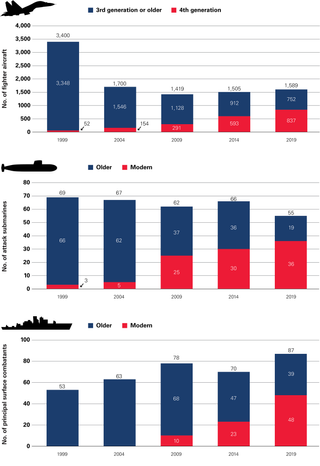
Since the mid-1990s, China has rapidly transformed its military from an antiquated Soviet-era institution into a sophisticated fighting force that is optimised to challenge American power projection assets. This has occurred on the back of stellar economic growth. Chinese defence spending rose by approximately 900 per cent between 1996 and 2018, permitting the People’s Liberation Army (PLA) to sustain an impressive tempo of military modernisation across most key capability areas.48 Its advances in missiles, fighter jets, attack submarines and surface ships have been particularly striking in qualitative and quantitative terms. Although the PLA has yet to catch-up with the US military, Eric Heginbotham and other leading defence analysts point out that “the trendlines are moving against the United States across a broad spectrum of mission areas”.49 More to the point, because China would enjoy a home-court advantage in the case of a regional conflict, “it does not need to catch up to the United States to dominate its immediate periphery”.50
Figure 3: China’s missile inventory, 2004-2019
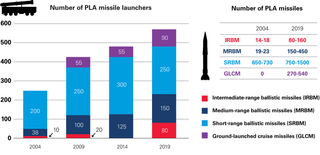
China’s increasingly favourable position in the regional balance of power is a product of the way Beijing has modernised and postured its armed forces. Crucially, the PLA’s development of anti-access/area denial (A2/AD) capabilities has been explicitly designed to challenge American military primacy by raising the costs and risks to US forces in the Western Pacific.51 Its massive investment in conventionally-armed ballistic and cruise missiles is the centrepiece of China’s “counter intervention” efforts.52 Over the past 15 years, the PLA has systematically increased, upgraded and extended the range of its inventory of missiles and launchers in what the US government has called “the most active and diverse ballistic missile development program in the world”.53 Although exact numbers are uncertain, the Pentagon estimates that the PLA Rocket Force now fields up to 1500 short-range ballistic missiles, 450 medium-range ballistic missiles and 160 intermediate-range ballistic missiles, in addition to hundreds of long-range ground-launched cruise missiles.54 These can strike targets throughout the First Island Chain and beyond, placing Japan, South Korea, Taiwan, the Philippines and Singapore well within China’s A2/AD threat envelope; and, in the case of the DF-26, extending this missile threat as far as the US territory of Guam, the location of major Air Force and Navy forward operating bases. China has also developed a specialised anti-ship ballistic missile, the DF-21D, which it recently test-fired from the mainland into the South China Sea, and is rolling-out a number of sea- and air-launched cruise missiles variants which will further extend the range and scale of its conventional missile threat.55 Looking to the future, China may well be ahead of the United States and its allies in developing advanced hypersonic missiles that would significantly worsen this threat environment.56
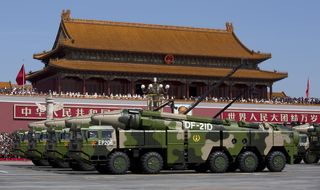
This growing arsenal of accurate long-range missiles poses a major threat to almost all American, allied and partner bases, airstrips, ports and military installations in the Western Pacific.57 As these facilities could be rendered useless by precision strikes in the opening hours of a conflict, the PLA missile threat challenges America’s ability to freely operate its forces from forward locations throughout the region. Alongside China’s broader A2/AD capabilities — including large numbers of fourth-generation fighter jets, advanced C4ISR systems, modern attack submarines, electronic warfare capabilities and dense arrays of sophisticated surface-to-air missiles — it permits the PLA to hold US and allied expeditionary forces at risk, preventing them from operating effectively at sea or in the air within combat range of Chinese targets.58 Following Beijing’s construction of a network of military outposts in the South China Sea that can support sophisticated radars, missile batteries and forward-based aircraft, the A2/AD threat is further intensifying in this critical waterway.
Figure 4: China’s growing missile threat to US bases and regional access locations
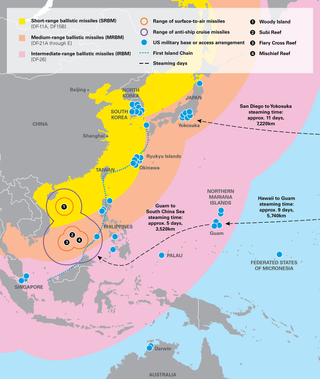
Preventing a Chinese fait accompli to preserve regional order
China’s formidable military power within the First Island Chain could have dire consequences for the regional order. This is because it provides Beijing with the coercive leverage it would need to quickly seize coveted territory or overturn other aspects of the status quo by pursuing a fait accompli strategy. Referring to the ability of a challenger to achieve its revisionist objectives before a defender or its partners can mobilise sufficient forces to respond, strategists are increasingly worried that China might accomplish a fait accompli by launching a limited war or “grey zone” operation under the cover of its A2/AD umbrella.59 At the most ambitious end of the spectrum, Beijing may attempt to reunify Taiwan by force — either through a direct assault, blockade, or some kind of hybrid attack involving kinetic, cyber and political warfare — exploiting surprise and local military superiority to its advantage.60 Similarly, and more plausibly in the near-term, the PLA might be emboldened to seize smaller targets such as the Japan-administered Senkaku/Diaoyu Islands in the East China Sea, features belonging to US allies or partners in the South China Sea like Scarborough Shoal and parts of the Spratly Islands, or Japanese territories along the First Island Chain, particularly in the Ryukyu Islands archipelago.61 In all these scenarios, Beijing’s aim would be to strike first to secure longstanding political goals or strategically valuable objectives before the United States can do anything to stop it.
Asymmetries in power, time, distance and interest would all work against an effective American response. Under present-day US posture in the region, most American and allied bases and forward-deployed ships, troops and aircraft would struggle to survive a PLA salvo attack, and would be initially forced to focus on damage limitation rather than blunting the thrust of a Chinese offensive.62 American forces that are able to operate would be highly constrained in the early phases of a crisis — lacking air and naval dominance, outnumbered by their PLA equivalents and severely challenged by the loss of enabling infrastructure, like functioning airstrips, fuel depots and port facilities, all of which would be at least temporarily degraded by precision strikes.63 Reinforcements from outside the A2/AD threat envelope would take considerable time to arrive from Hawaii or the US west coast and, as former Commandant of the US Marine Corps General Robert Neller has warned, they would first “have to fight to get to the fight”.64 Although the United States would probably — but not certainly — prevail in an extended war, escalation at this point would be enormously costly and dangerous. Herein lies the nub of a fait accompli: Because America’s interests in the security of its allies are “fundamentally secondary” to its own survival, and arguably less tangible than the core interests Beijing has at stake in many of these flashpoints, Washington may ultimately wager that intervention is not worth the candle.65
The broader ramifications of a Chinese fait accompli would be devastating for the Indo-Pacific balance of power and the stability of America’s alliance and partner network. In a direct sense, China’s seizure of strategic locations along the First Island Chain, such as key nodes in Japan’s Ryukyu Islands archipelago, would provide the PLA with significant military advantages. These could include: Bolstering its ability to threaten US and regional forces, enhancing its capacity to project power into the East China Sea and over Taiwan, and isolating Japan in a crisis from its security partners to the southwest.66 At the diplomatic level, the failure to prevent a Chinese attack on allied territory would exacerbate rising concerns about America’s capacity and willingness to act as a security guarantor in the region.67 Indeed, the mere fact that Washington might have to rely on military escalation and protracted conflict to defeat Chinese aggression is already eroding the credibility of its security assurances in certain quarters.68 The flow-on effects of uncertainty about American security commitments will vary according to countries and crises; but may well erode the willingness of allies and partners to support, sustain and contribute to upholding the US strategic position in the region — particularly if they think this exposes them to other forms of coercion by Beijing.69 This would further accelerate the unfavourable shift against America in the evolving balance of power.
By refocusing on a strategy of deterrence by denial and working to directly defend against a PLA attack, the Pentagon aims to avoid this chain of events. The logic of its new warfighting approach is sound: As China’s “theory of victory” is premised on its ability to employ limited force to achieve quick strategic payoffs and splinter regional alliance cohesion in the process, it follows that anything which makes this opportunistic course of action more dangerous is likely to give Beijing pause to think twice.70 Accordingly, the NDS calls for a layered approach to actively defending against prospective Chinese aggression. This includes “contact” forces to compete below the threshold of armed conflict; a resilient layer of “blunt” forces to “delay, degrade, or deny” a fait accompli by inflicting significant costs on attackers and preparing the battlespace for reinforcements; and a “surge” layer of “war-winning forces” that would later flow into the theatre to tilt the balance and manage escalation.71 It is, in many respects, a return to the kind of denial strategy that the United States employed during the Cold War in Europe to deter numerically superior Soviet forces from launching limited land grabs around its periphery.72 Crucially, like its successful forebear, deterrence by denial in the Western Pacific does not depend on local military superiority or all-domain dominance to succeed.73 Provided that America’s forward-deployed assets can weather a PLA assault and degrade its attacking forces to the point where Beijing — rather than Washington — is faced with the unappealing prospect of dangerous escalation, US and allied forces could deter the outbreak of violence even in the absence of military primacy.74
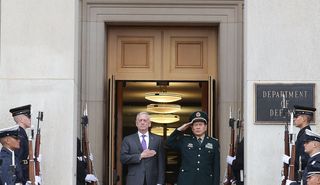
Implementing this strategy, however, will not be easy or cheap. On the contrary, it will require major changes to the US military’s force structure, regional posture and concepts of operations, only some of which are currently in train. Above all, the Pentagon will need to increase the “lethality” and “resilience” of its forward-deployed forces to enable them to “survive, operate and win” inside China’s A2/AD threat envelope.75 As RAND analyst David Ochmanek and other strategists have explained, some of the requirements will include: Advanced air, sea and submarine assets that can exploit stealth and long-range strike to rapidly neutralise PLA attacking forces, air defences and C4ISR systems; larger stockpiles of long-range standoff munitions, including ground-based artillery, to hold aggressors at risk in the early stages of combat; expendable drones and other low-cost assets to ensure situational awareness and deny it to opponents; and distributed basing arrangements, decoys and point defences to bolster the resilience and agility of US and allied forces.76 All this will need to be stitched together with new operational concepts — notably missing in the unclassified NDS, but under development in the Pentagon and wider defence community — to conceptualise how America will be able to conduct this new way of war and thereby strengthen deterrence in the Indo-Pacific.77 This places a premium on costly efforts to modernise the Joint Force, research and develop cutting-edge capabilities, and test new concepts through tailored wargames and experimentation.
“Without substantial and sustained increases in investments in new equipment and operating concepts, the credibility of US security guarantees to allies and partners in East Asia will continue to erode”.David Ochmanek, former Deputy Assistant Secretary of Defense for Force Development.[78]
The Pentagon will also need to manage its forces differently to successfully implement a credible denial strategy against a great power like China. In contested parts of the Indo-Pacific, this means recalibrating America’s military presence to prioritise the “warfighting ability” of forward-deployed forces ahead of the reassurance of allies and partners.79 Although this may involve politically difficult decisions — such as reducing the footprint of vulnerable assets like aircraft carriers, or dispersing large concentrations of US forces from parts of Japan to locations further afield — such changes are critical to fielding a more survivable and therefore credible Joint Force. Globally, the trade-offs required will demand even more strategic discipline. Given the stresses of preparing for a possible conflict with China — in terms of cost, modernisation, readiness and training, etc. — the Joint Force will have to scale back other responsibilities, particularly in secondary regions like the Middle East. This is what the architects of the NDS mean by “prioritizing” great power competition.80 Rather than expending high-end resources and military readiness on strategically insignificant missions — such as using F-22s and B-1 bombers to conduct strike operations against ISIS targets — the Joint Force will need to conserve its strength for developing, exercising and demonstrating the ability to hold the line against China in the Indo-Pacific.
America’s superpower mindset and the problem of strategic prioritisation
It is far from clear that Washington has the strategic discipline and political will to make the difficult trade-offs that a strategy of prioritising great power competition with China requires. This is the central challenge the Pentagon faces in implementing the National Defense Strategy in an era of strained resources and proliferating global threats. The problem is not that decisionmakers disagree with efforts to counter the burgeoning China challenge. On the contrary, there is a hardening bipartisan consensus in Washington that views China as the most serious long-term threat to America’s global interests and supports the NDS’ emphasis on bolstering conventional deterrence vis-à-vis China and Russia.81 The problem is that disagreement exists within the foreign policy establishment over whether and how the United States should pare back its other global commitments in order to focus defence resources on the Indo-Pacific.
It is far from clear that Washington has the strategic discipline and political will to make the difficult trade-offs that a strategy of prioritising great power competition with China requires.
At the heart of this dilemma is the persistence in American political and foreign policy circles of an outdated “superpower mindset” that regards the United States as sufficiently endowed in economic and military strength to not have to make strategic trade-offs.82 Those adhering to this primacist school of thought fundamentally reject the idea that Washington should limit its defence strategy and liberal order-building agenda in order to conform with present-day resource constraints.83 One of the rationales for this position is the conventional wisdom that America’s superpower status hinges on its ability to prevail in at least two simultaneous “major regional contingencies”, in addition to prosecuting a wide array of less demanding global security tasks.84 The 1997 Quadrennial Defense Review, a precursor to the NDS, defined this strategic bandwidth as “the sine qua non of a superpower”.85 And as the international security landscape deteriorated over the intervening 22 years, leading voices on both sides of the political spectrum have called for sustaining or increasing America’s capacity to fight multiple adversaries at once — even as the Department of Defense has found the tempo of counterinsurgency and state-building operations to be increasingly debilitating in light of enduring budget constraints.86 This mainstream commitment to “reinvesting in primacy”, to paraphrase Hal Brands and Eric Edelman, is seen as essential to sustaining America’s position as the defender of a vast liberal order and global network of allies and partners.87 Crucially, its adherents urge Washington not to make choices between preparing for strategic competition with China and Russia, deterring rogue states like Iran and North Korea, combating global terrorism, fighting insurgents or promoting democracy in post-conflict states.88
This mindset is alive and well in Washington today, even among those who support the NDS and its elevation of great power competition to the top of America’s strategic priorities. Speaking at West Point earlier this year, Vice President Mike Pence laid out an expansive vision for America’s future military engagements, telling a cohort of graduating cadets that “it is a virtual certainty” they or their peers “will fight on a battlefield for America” in places as diverse as Afghanistan, Iraq, North Korea, the broader Indo-Pacific, Europe and the Western Hemisphere.89 While these remarks are not striking by the normal standards of Washington’s interests, coming from the administration’s leading public voice on the need to “take decisive action” against China’s efforts to undercut America’s global pre-eminence, Pence’s comments belie the inherent difficulty in trying to maintain strategic discipline.90
In fact, for a sizable majority of current and former officials, lawmakers, military leaders and think tank analysts, the Pentagon’s new focus on great power competition is viewed as an additional task for the Joint Force to manage alongside — not instead of — its other global commitments.91 Contending that the United States faces mounting threats to its global interests and those of its allies and partners, many hold that the so-called “4+1 framework” for focusing American defence strategy — namely: Russia, China, North Korea, Iran and transnational terrorism — remains an appropriate baseline assumption for the day-to-day demands that the Joint Force must manage, even if China now sits at the top of this list.92 For instance, while US lawmakers over the past 18 months have shown growing concern for the “pre-eminent” challenge China presents, many still see Russia as the most urgent threat, oppose troop withdrawals from Afghanistan and Syria, worry about premature détente on the Korean Peninsula, and are divided along partisan lines regarding the threat posed by Iran.93 Likewise, the US military’s combatant commanders for Europe, the Middle East, Africa and South America continue to emphasise the severity of threats emanating from their geographic areas of responsibility — including by highlighting the global scope of malign activities by China and Russia that warrant greater resources; and, in the case of US Central Command Commander General Joseph Votel, arguing that the NDS does not foreshadow a “wholesale shift in emphasis away from the Middle East and Central Asia regions”.94

Even the bipartisan panel of defence experts on the National Defense Strategy Commission, all of whom agree that “major power competition [with China and Russia] should be at the center of the department’s strategy”, have accused the Pentagon of “under-resourcing” other threats to US security interests. Epitomising America’s superpower mindset, they conclude: “Because the United States remains a global power with global obligations, it must possess credible combat power to deter and defeat threats in multiple theatres ... and near-simultaneous contingencies”.95
While the US military is, to be sure, capable of undertaking multiple global responsibilities at once, the sheer number and magnitude of the tasks it is being called on to address poses a severe and ongoing problem of strategic insolvency. Reigning in the scope of America’s expansive grand strategy will be a fraught — and probably insurmountable — policy challenge, given the vested political, diplomatic and institutional interests that lie behind Washington’s longstanding global commitments. For instance, as analysts Rick Berger and Mackenzie Eaglen point out, the call by supporters of the NDS to scale back security commitments to the Middle East is “outside the mainstream of American foreign policy”, variously opposed by politicians, the general public and much of the national security establishment.96 Similarly, suggestions that the Pentagon curtail the “symbolic” deployment of forces to allied countries to “assure” them of American security commitments, or that it accept greater risks in “lower priority” regions like the Middle East by undertaking operations with less sophisticated military assets, are also likely to encounter significant push-back.97 Although much will depend on the way that the Department of Defense “right-sizes” the Joint Force to balance core and peripheral mission sets, there are few reasons to be optimistic about Washington’s ability to quickly or significantly reorient the strategic ship of state to truly prioritise the Indo-Pacific ahead of other regions.
In fact, recent history shows that the Indo-Pacific has actually been short-changed insofar as targeted investments in regional security initiatives are concerned. Since 2015, American deterrence efforts in Eastern Europe and combat support efforts in the Middle East have received large-scale funding packages through the Pentagon’s annual budget, whereas comparable initiatives for the Indo-Pacific have been absent or under-resourced. Setup in the wake of Russia’s annexation of Crimea, the European Deterrence Initiative received US$16.5 billion through FY2019 to bolster military exercises with partner states and strengthen US defence facilities, presence and rotations in the region.98 Meanwhile, the Iraq, Syria, and Counter-ISIS Train and Equip Fund and the Afghan Security Forces Fund received a combined US$28.94 billion to support the burgeoning counterinsurgency and counterterrorism abilities of America’s regional partners.99 By contrast, the Indo-Pacific during the same timeframe received just US$259,000 through the Maritime Security Initiative for partner assistance and training in the wake of Chinese assertiveness in the South China Sea.100 Even if one counts a number of smaller defence initiatives in the Indo-Pacific theatre and the newly-established Asia Reassurance Initiative Act — which earmarks $1.5 billion per year for security programs — these regional funding discrepancies highlight the relative pull of American security interests in other parts of the world.101 As Eric Sayers, formerly of US Indo-Pacific Command, observes: “The issue remains that the scale of resource commitment to the region continues to fall short of the sizable objectives the US government has set for itself”.102
Since 2015, American deterrence efforts in Eastern Europe and combat support efforts in the Middle East have received large-scale funding packages through the Pentagon’s annual budget, whereas comparable initiatives for the Indo-Pacific have been absent or under-resourced.
The way that the Department of Defense has calibrated its budget requests since the NDS was released also indicates how a long-term strategy of prioritising great power competition with China could be undermined by preparations for other global contingencies. Rather than channelling the lion’s share of major new investments into next-generation military capabilities for future high-end warfighting needs, the FY2019 and, to a lesser extent, FY2020 requests over-emphasised restoring readiness, preparing for near-term military operations, and maintaining the overall size of the force.103 Both also allocated broadly consistent levels of funding across the military services, even though a strategic focus on great power competition in the Indo-Pacific would likely favour the Navy and Air Force.104 As budget expert Susanna Blume explains, these choices are out of sync with the NDS’ objective to prioritise capability over capacity.105 While significant investments were made in areas conducive to the strategy — including modernisation, research and development, and the procurement of advanced munitions and autonomous systems — both budgets spread resources more evenly between capability, capacity and readiness than supporters of the NDS expected.106 This belies a reticence to make hard strategic choices. Crucially, it signals that decisionmakers are unwilling to accept near-term risks to America’s ability to respond to multiple global contingencies, in return for honing its warfighting edge to deter China in the future.
In the absence of Washington’s ability or willingness to scale back its ongoing global commitments, the only sure way of resourcing the Pentagon’s strategy to restore conventional deterrence vis-à-vis China is to increase the size of the defence budget. This is the preferred course of action for those who favour a return to primacy and consolidation of America’s superpower status.107 It is, however, a worryingly unrealistic and imprudent aim. Although exact numbers are hard to predict and vary between analysts, many agree with the National Defense Strategy Commission’s ballpark judgement that 3-5 per cent annual growth above inflation would be required for the United States to combat the threats posed by China, Russia, Iran, North Korea and global terrorism at acceptable levels of strategic risk.108 One assessment by RAND puts the cumulative gap between America’s current defence spending projections and the requirements of this expanded strategy at more than US$500 billion by 2027.109 Such increases are highly unlikely to happen and even less likely to be sustained. Not only does the administration’s FY2020 budget request fall just outside of its own minimum target at 2.8 per cent real growth, but the wider politics of the US defence budget are likely to complicate and constrain available resources for the foreseeable future.
Part 2: Defence budget constraints
The US defence budget is under mounting pressure. America’s armed forces need sustained and predictable growth in financial resources in order to implement the National Defense Strategy. But achieving this objective will require a marked and ongoing shift in the political status quo that has taken hold in Congress. The impact of the Budget Control Act’s legislative caps on defence spending over the past decade, coupled with repeated funding delays and budgetary uncertainty, has hobbled America’s ability to effectively respond to a shifting strategic landscape in the Indo-Pacific. Although the past few years have seen promising steps towards rectifying these shortfalls, the reality is that the NDS remains underfunded.
Political trends within Congress and long-term fiscal challenges facing the United States suggest that the misalignment between American strategy and resources is likely to continue. Growing ideological polarisation between Republicans and Democrats over national spending priorities, coupled with declining public support for higher military spending, will likely impede the political consensus required to achieve 3-5 per cent real growth in annual defence expenditure through 2023 as recommended by the National Defense Strategy Commission. The spectre of looming deficits and historically high levels of public debt will further complicate the process by which diverging partisan objectives can be resolved, constraining budget top lines into the future.
At the same time, key elements within the US defence budget itself are displaying worrying signs of becoming unsustainable. The defence dollar’s purchasing power is under strain from growing internal costs, while numerous accounts are ballooning above inflation such as military healthcare, compensation of personnel, maintenance of aging equipment and the acquisition of next-generation platforms.
Efforts to address these structural issues remain incomplete. Although recent increases to the US defence budget have started to rebuild the armed forces for strategic competition, America’s political and military leaders have continued to add missions, roles and responsibilities to an already overstretched Joint Force. Funding, meanwhile, has remained inconsistent. Continued unwillingness to confront politically difficult decisions regarding America’s national defence means that, based on present trends, the United States will face a deepening crisis of strategic insolvency.
America’s troubled defence budget
On 9 February 2018, President Donald Trump signed into law the biggest year-to-year increase in defence spending since 2003.110 News outlets and commentators were quick to declare the Bipartisan Budget Act of 2018 (BBA) “a Pentagon budget like none before”,111 characterising the increase to defence spending as “the upper limit of what anyone thought was possible”.112 This language was not entirely hyperbolic: Congress defied years of convention by providing more funds for defence in the BBA than requested in the president’s budget, in an agreement that dwarfed the rate of past increases to Budget Control Act (BCA) spending limits by more than three times over.113 While previous legislative deals to soften the impact of the BCA had been relatively modest, the BBA added US$80 billion to defence spending in FY2018 and $85 billion in FY2019 — representing a real increase of approximately 11 per cent.114 This year Congress has passed another bipartisan spending deal to cover the remaining two years of the BCA. Under this agreement, spending on defence is set to reach US$738 billion in FY2020 and US$740.5 billion in FY2021, a comparatively modest increase that shrinks to a flatline with inflation from the following year.115

Both of these short-term political fixes, however, obscure longer-term barriers and evolving partisan dynamics in Congress that will prevent sustained and predictable budget increases of a similar scale in the future. Rather than heralding a new era for US defence spending, they illustrate an overdue attempt by legislators to offset some of the damaging results of spending limits imposed by the BCA. Importantly, they do not form a model for spending agreements following the expiration of these caps in 2021 and beyond.
Between 2011 and 2018, total spending on US national defence declined in real terms by 21 per cent.116 In the lead-up to the passage of the BBA, a targeted campaign by the late Senate Armed Services Committee Chairman John McCain (R-AZ) and then-House Armed Services Committee Chairman Mac Thornberry (R-TX) brought home the reality of America’s military readiness crisis to lawmakers, successfully linking defence spending cuts with a string of US Navy collisions at sea.117 Republican defence hawks were able to capitalise upon political momentum to raise spending in a crucial midterm election year, when their party had unified control of government and was keen to deliver a key election promise made by President Trump. Democrats, for their part, were motivated by a desire to deliver a “win” to their political base from a position of relative legislative weakness by demanding comparable increases to domestic spending in return for their support.118 Yet, even following his successful stewardship of the deal, Thornberry was quick to warn “it would be a mistake” to view the BBA as a silver bullet for the Pentagon, stating that “not everything is fixed because we have a substantial increase in one year” and quipping “the closer you look, the deeper the problems are”.119
While agreements have been reached to increase the resources available for America’s national defence, these funds represent a broader political compromise rather than a concerted effort to remedy the misalignment between resources and strategy.
Many of these problems are deeply ingrained. The US defence budget has faced significant downward pressure and decreased buying power over the past decade. As the National Defense Strategy Commission report shows, even factoring in the US$237 billion of cumulative defence funding added by the BBA and two previous budget deals in 2013 and 2015, BCA-imposed spending caps have still resulted in a net US$539 billion reduction in base budgets between 2012 and 2019, relative to former Secretary of Defense Robert Gates’ final spending plan before the BCA became law.120 While the US$700 billion of enacted defence spending resulting from the BBA in FY2018 was a significant increase from the previous fiscal year, growth in the budget’s top line to US$716 billion in FY2019 was on par with inflation and has by no means undone the damage of cumulative spending shortfalls since 2011.121
Worryingly, the most recent congressional budget deal continues this trend into the future. While agreement has once again been reached to increase the resources available for America’s national defence, these funds have been provided as part of a broader political compromise rather than a concerted effort to remedy the overall misalignment between resources and strategy. A statement released by the Democratic Congressional Progressive Caucus — a key voting bloc that ensured the bill’s passage in the House — stated that their support “does not address the bloated Pentagon budget, but it does begin to close the gap in funding for families, by allocating more new non-defence spending than defence spending for the first time in many years”.122
Put simply, recent developments in Congress have failed to achieve sustained real growth in the defence budget, illustrating the significant political barriers to achieving this objective and raising questions regarding the viability of similar deals moving forward. Following the passage of the BBA, Chairman of the House Armed Services Committee Adam Smith (D-WA) predicted that “the odds are, this is the largest the defence budget is going to be for, probably, about the next decade”.123 Smith’s prognosis is already becoming a reality. The Trump administration’s FY2020 “masterpiece” budget requested an increase of only 2.8 per cent in real terms over the Department of Defense’s enacted spending for FY2019,124 with growth in the administration’s Future Years Defense Program through 2023 annualising to just 2.1 per cent.125 While this year’s spending deal provides another two years of budget predictability for the Pentagon, it also fails to implement the administration’s requested top line of US$750 billion — falling short of the National Defense Strategy Commission’s recommended 3-5 per cent growth at precisely the time that the department’s internal costs are predicted to rise.126
The congressional budget process and Budget Control Act of 2011 |
|
The US Constitution invests Congress with the “power of the purse” and the responsibility to determine federal spending through its budget process. Discretionary spending — including for national defence — is provided by annual appropriation bills and forms the focus of congressional efforts to fund the federal government. Mandatory spending — including entitlement programs such as Social Security, Medicare and Medicaid — is generally determined by existing statutory criteria and is provided in permanent or multi-year appropriations.[^127] Since the passage of the Gramm-Rudman-Hollings Act in 1985, Congress has periodically imposed budget enforcement mechanisms such as “caps” on discretionary spending in order to achieve broader fiscal objectives. Between FY2009 and FY2012, reduced tax revenues and economic stimulus undertaken in response to the global financial crisis resulted in federal deficits averaging their highest percentage of GDP since the Second World War.[^128] Republicans and Democrats in Congress were split over the amount and process by which the deficit should be reduced. In 2011, this partisan discord converged with the need to increase the federal debt ceiling. Following their electoral success in the 2010 midterms, newly emboldened Tea Party Republicans sought deficit reduction solely through decreased federal spending, while Democrats pressed for tax increases to offset some of the need for these austerity measures.[^129] The impasse put the US economy on the brink of a default and fiscal crisis, eventually forcing President Barack Obama to sign the Budget Control Act of 2011 (BCA) in August after extended negotiations with congressional leaders. In return for a US$2.1 trillion increase to the debt limit, the BCA amended the Gramm-Rudman-Hollings legislation to reinstate spending limits on discretionary spending between FY2012 and FY2021, creating US$917 billion of projected savings over the ten-year period.[^130] It also established a bipartisan “super-committee” to devise further savings of at least US$1.2 trillion. When the committee failed to agree on additional deficit reduction measures, automatic spending-cut provisions included within the BCA known as sequestration went into effect in March 2013, resulting in US$50 billion of across-the-board cuts for defence and non-defence spending. Congress was able to offset some of these cuts through a subsequent spending deal in 2013 and has repeatedly voted for deals to raise the BCA caps through spending agreements thereafter. If Congress had failed to reach another deal this year, approximately US$71 billion of automatic budget cuts to defence spending and US$55 billion to non-defence spending would have gone into effect in January 2020.[^131] Spending limits imposed by the BCA have been a source of political contestation since their enactment.[^132] Proponents of the legislation argue that the provisions help restrain rising debt and deficit levels. However, members of the defence establishment have taken a different approach, arguing that such reductions “present a grave and growing danger to our national security”.[^133] |
Figure 5: Changes to Budget Control Act limits on national defence
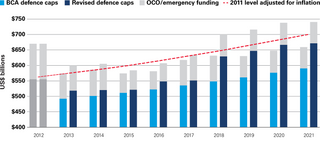
Congress and the politics of the defence budget
In recent years, congressional dysfunction has repeatedly created political fixes for America’s national defence at the expense of its broader strategic objectives. Debates over the size and shape of the US defence budget are necessarily filtered through competing social, political and electoral considerations within Congress. This process, however, has become increasingly difficult for major parties and individual lawmakers to navigate as polarisation and ideological hardening has grown in the national legislature. While partisan politics and deal-making are inherent features of America’s democracy, the growing extent to which these elements have been used as tools of electoral advantage has derailed traditional budgetary timelines and hindered targeted and long-term planning by
the Pentagon.134
The federal budget process is designed to adhere to an orderly schedule, commencing with the president’s annual budget request each February. After consideration by relevant committees, Congress is tasked with passing a series of 12 spending bills that fund various agencies and activities of the federal government, including the Department of Defense. These appropriations bills require a supermajority of 60 votes to pass the Senate, meaning that bipartisan cooperation and trade-offs are vital. But the traditional point of friction in the US political system that is meant to elicit legislative compromise — that between Congress and the executive — has increasingly drifted towards partisan clashes within the legislative branch. As a result, adherence to budget processes and deadlines has declined in recent congresses as both parties have increasingly used budget chokepoints to force policy adjustments from the opposing side.135 Because of its “must-pass” nature, disputes over the federal budget have regularly become a key vehicle for lawmakers from both major parties to voice ideological disagreements, leading to a dysfunctional culture of brinkmanship, crisis policymaking and legislative gridlock.136
“As hard as the last 16 years of war have been on our military, no enemy in the field has done as much to harm the readiness of the US military than the combined impact of the Budget Control Act’s defense spending caps, worsened by operating for 10 of the last 11 years under continuing resolutions of varied and unpredictable duration”.Former Secretary of Defense James Mattis, 6 February 2018
Funding for the Pentagon and related programs comprises more than 50 per cent of annually appropriated federal spending and is heavily shaped by broader contestation over national priorities. The concurrent impact of BCA caps on both defence and non-defence spending has exacerbated existing partisan disagreement over the appropriate allocation of resources within the overall budget, creating delayed timelines for the Department of Defense. For example, stalled negotiations over setting new BCA caps forced the Pentagon to operate under a continuing resolution for an average of 138 days between 2011 and 2018.137 The cumulative effect of politicisation on the defence budget was highlighted by former Secretary of Defense James Mattis in 2018, when he declared: “As hard as the last 16 years of war have been on our military, no enemy in the field has done as much to harm the readiness of the US military than the combined impact of the Budget Control Act’s defense spending caps, worsened by operating for 10 of the last 11 years under continuing resolutions of varied and unpredictable duration”.138 But while the BCA has introduced unique political hurdles into the congressional appropriations process, partisan disagreement over national spending priorities is set to remain front-and-centre in budget debates, even following the scheduled expiration of the caps in 2021.
What are continuing resolutions and how do they impact the Department of Defense? |
|
Congress has often struggled to deliver its 12 regular appropriation bills on time — before the start of each fiscal year — since major reforms to the budget process in 1974. Instead, the US legislature has become reliant upon measures known as continuing resolutions — stop-gap spending extensions that prevent government shutdowns by preserving the previous year’s funding levels for a negotiated period. The deterioration of regular order in Congress has meant that the US federal government is often funded through lengthy continuing resolutions or omnibus appropriations measures that combine the 12 separate spending categories into one must-pass bill.[^139] Over the past decade, appropriations for the Department of Defense have been significantly impacted by this trend. Continuing resolutions serve a political purpose in that they provide Congress with a longer window to reach budget agreement.[^140] However, they impose substantial military and defence costs on the Pentagon due to the lack of flexibility, budget uncertainty and the inefficiencies they create. Continuing resolutions restrict how funds can be spent by the department and block movement between accounts through traditional reprogramming. In practice, this means a freeze on hiring, contracts and the initiation of new programs that were not authorised and appropriated for in the previous fiscal year.[^141] These constraints force the Pentagon’s leadership to focus on the short rather than long term. In March 2017, then-Chairman of the Joint Chiefs of Staff Joseph Dunford testified that “eight years of continuing resolutions and the absence of predictable funding has forced [the Department of Defense] to prioritise near-term readiness at the expense of modernization and advanced capability development”.[^142] Further, Congress’ inability to provide funding in a timely or predictable basis has prompted inefficient, “use-it-or-lose-it” spending and impacted long-term modernisation programs.[^143] |
Figure 6: Number of days the Pentagon has operated under a continuing resolution since 2002
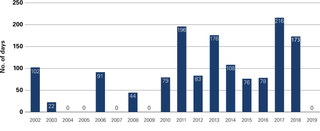
Partisanship, polarisation and barriers to the National Defense Strategy
Without reform to its global security commitments, America will need sustained and predictable growth in the defence budget in order to implement the National Defense Strategy. But the recurring partisan battles between Republicans and Democrats over the appropriate top-line budget for the Pentagon each year raise significant questions over whether such stability is achievable in the near-term. These diverging priorities are what have made previous BCA cap deals hard to broker and relatively modest in scope — focused more on piecing together a legislative majority to keep the government open, rather than pursuing America’s strategic objectives.144 The most recent deals that have seen limited real growth in the defence budget were based on mutual convenience and electoral considerations in the lead-up to the 2020 presidential election, rather than a unity of purpose on defence strategy and spending.145 This unstable situation will face mounting stress as opportunities decline for Republicans and Democrats to resolve their differences over defence spending and pursue joint priorities, and as they continue to fracture along ideological and party lines.146
Within the Republican Party, there is a broad degree of consensus on the need for increased defence spending across “defence hawks”, the Freedom Caucus and other fiscal conservatives. But internal divisions exist among party members over the best approach to achieve this goal. These divisions stem largely from ideological disagreements on the appropriate levels of non-defence discretionary spending, cuts to mandatory programs and the overall size of budget deficits — issues which have delayed the release of Republican budget resolutions in recent years.147 Even in the period between 2016 and 2018 — when Republicans enjoyed unified control of Congress — these intra-party divisions meant that party leadership lacked confidence in their ability to pass spending bills without substantial Democratic support.148 This disunity has continued in the party’s current minority status in the House, with only 65 Republicans voting for — and 132 voting against — the July 2019 spending deal despite a strong endorsement by President Trump.149 Even with 53 Republican senators in the current Congress through 2020, divisions inside the Republican caucus and structural requirements for bipartisan compromise within the budget process have empowered Democrats to demand equal increases to non-defence spending in each round of negotiations over relaxing budget caps.
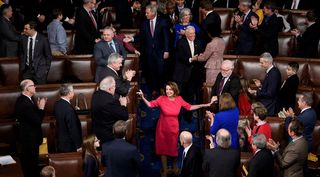
Within the Democratic Party, by contrast, tensions emerge from internal disagreement regarding the elevation of domestic priorities above national defence. The party’s success in the 2018 midterms illustrates growing ideological diversity within the Democratic caucus, highlighting a key point of difference with the Republican Party who are united on the ends but divided on the means to achieve higher defence spending. Progressive Democrats have argued for reductions in military spending in order to fund more ambitious domestic policies, while some centrists and fiscally-conservative “Blue Dog” Democrats have sought to position themselves as strong on defence and supportive of the armed services.150 As such, Democratic leaders in the House have had to navigate an often contradictory strategy that backs progressive policies, such as Medicare-for-All, while simultaneously acknowledging the role that moderate Democratic candidates played in unseating Republicans in historically conservative districts in 2018.151 Lawmakers within the party who campaigned during the midterms on a progressive platform have increasingly come up against party leaders who have presented generous positions on defence bills as opening offers in broader discussions over federal spending.152 This internal divide within the party matches a split in ideology among Democratic voters: self-styled liberal, moderate and conservative Democratic voters vary significantly in their opinions on whether America is spending too much on defence.153
Diverging ideological stances on defence spending are likely to continue as partisan polarisation persists in Congress, gaining salience in the lead-up to the 2020 presidential election and beyond.
Diverging ideological stances on defence spending are likely to continue as partisan polarisation persists in Congress, gaining salience in the lead-up to the 2020 presidential election and beyond.154 According to an American Political Science Association task force on the breakdown of negotiation in US politics, polarisation within Congress stems from both “sincere ideological differences about policy” and “strategic behaviour [designed] to exploit those differences to win elections”.155 As lawmakers have increasingly moved away from the ideological centre, party unity — where a majority of Democrats vote against a majority of Republicans or vice-versa — has risen dramatically in recent decades. The combination of these hardened ideological convictions and increasingly competitive elections — in which a shift in party control of one or both houses of Congress or the presidency is likely — decreases the overall willingness and opportunity for the kind of bipartisan cooperation that is required for achieving compromise on issues of public importance like national defence.156 In short, recurring partisan battles and political dynamics within Congress will continue to impede full implementation of the NDS for the foreseeable future.
Figure 7: Growing ideological division within Congress

Looming fiscal challenges facing the United States
America’s soaring federal debt and the threat of long-term fiscal imbalance is set to make budget agreement within Congress even more difficult. Over the next decade, federal deficits — the shortfall between government spending and revenue — are expected to average 4.3 per cent of GDP.157 This is significantly higher than the average 2.9 per cent of GDP over the past 50 years.158 Following the period of intense focus on deficits that led to the creation of the BCA in 2011, short-term improvements in America’s fiscal outlook have seen concerns about the national debt among the broader public go into hibernation, even as annual deficits have risen.159 Just under half of Americans surveyed by the Pew Research Center in January 2019 said reducing the budget deficit should be a top policy priority for the government, lower than the 72 per cent of those surveyed on the same issue in 2013.160
This downturn in concern has also been reflected in key policy decisions by Congress. The suite of personal income and corporate tax cuts passed by the Republican-controlled Congress in 2017 are projected to increase the deficit by approximately US$1.9 trillion over the next decade, putting further downward pressure on the discretionary funds available for national defence.161 Throughout the BCA era, budget negotiations followed a consistent pattern whereby Republicans demanded increases to national defence, while Democrats demanded comparable gains to achieve their domestic objectives. The most expedient political solution for reaching consensus has often been increased spending — albeit with some offsets — in both categories. Yet, while previous deals to raise the budget caps were largely compensated by reductions in other areas, the BBA of 2018 failed to achieve this to the same extent, resulting in a US$258 billion net increase in federal spending without an accompanying growth in revenue.162 With this year’s spending deal set to raise the federal debt ceiling and overall government spending by more than US$320 billion — this time with only US$77 billion in offsets — US political leaders are again pushing the risk of fiscal crisis further down the road.163
Federal agencies have consistently warned that rising levels of debt have the potential to negatively impact America’s national security by constraining overall military spending and limiting the country’s ability to respond to crises.
In other words, as economic concerns have lost a degree of political salience in Congress and among the American public more broadly, deficits have substantially grown and will complicate the basis upon which future spending deals can be brokered. President Trump’s FY2020 budget request — which was itself based on excessively rosy growth assumptions — implied as much, cautioning that “even with high levels of economic growth, excessive deficits continue to threaten the nation’s progress, and any unforeseen shocks to the economy could make deficits unsustainable”.164 At present, the total amount of US national debt is forecast to grow each year as the government runs budget deficits.165 Federal agencies have consistently warned that rising levels of debt have the potential to negatively impact America’s national security by constraining overall military spending and limiting the country’s ability to respond to crises.166 Given that the United States holds one of the highest debt-to-GDP ratios in the developed world — behind only Belgium, Portugal, Italy, Greece and Japan — this risk is rapidly becoming a reality.167 Indeed, US public debt is projected to reach US$28.7 trillion, or 93 per cent of GDP, by 2029, a high point not seen since just after the Second World War.168

These factors set the stage for further conflict within and between congressional Republicans and Democrats over the size of the defence budget, non-defence spending and entitlement reform. Crucially, as growing levels of public debt lead to bigger interest payments, debt servicing is set to eclipse total US national defence spending by 2023.169 These interest payments, coupled with other future drivers of debt — including mandatory spending programs such as Social Security, Medicare and Medicaid — are likely to “crowd out” the discretionary spending that funds defence, which is already at a historic low as a proportion of the US economy.170 An aging population and its accompanying healthcare requirements suggest that these costs will continue to grow at high rates into the future, with their widespread popularity making political reform difficult. Indeed, recent public opinion polling has shown that up to 70 per cent of Americans support increased spending for education, veterans, infrastructure and other government programs, while current enthusiasm for higher defence spending hovers at around 40 per cent.171
Figure 8: US federal outlays by type of spending
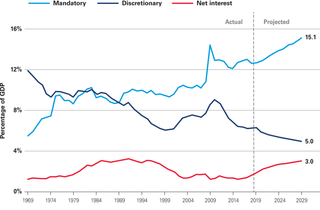
The fiscal challenges facing the United States are by no means new. Rather, they represent the long-term, cumulative impact of a number of politically expedient decisions that have disregarded America’s broader economic challenges. A US Government Accountability Office (GAO) report released in April 2019 warned that: “Congress and the administration face serious economic, security, and social challenges that require difficult policy choices in the near term in setting national priorities and charting a path forward for economic growth”.172 To put this in context, rising federal spending on entitlements and falling tax revenues will have a greater impact on America’s overall fiscal outlook than the portion of the federal budget allocated to defence.173
But while prospective policy solutions to easing federal deficits and curbing the national debt are widely accepted, they have been frequently dismissed by presidents and Congress as too difficult.174 Meanwhile the problem has steadily worsened. For instance, the last major deficit reduction plan proposed by the Simpson-Bowles Commission in 2010 advocated reducing deficits by 1.1 per cent of GDP over five years, rising to 2.2 per cent over a decade.175 This was cast as too substantial at the time. Today, an estimated US$5.2 trillion of savings are required to balance the federal budget in five years, representing a total of 4.4 per cent of GDP over the same period.176 Finding the political will to implement this level of spending reform is near impossible.
In light of these trends, the Pentagon is highly unlikely to see sustained periods of real growth even with a final deal to lift budget caps for the remaining two years of the BCA. Although the US economy has previously supported higher levels of defence spending as a percentage of GDP and of overall federal spending, the scale of the increases required to reach these historical levels appear politically infeasible in today’s peacetime economy with a population that is focused on other spending priorities. Indeed, defence spending is already near its peak in inflation-adjusted terms — higher than the average during the Cold War and at the height of the Reagan build-up.177 Barring a grand bargain in Congress to reform mandatory spending, the combination of a return to deficit politics among legislators coupled with America’s deteriorating fiscal outlook will constrain the political opportunities for reaching the annual 3-5 per cent increase in defence spending above inflation as recommended by the Pentagon and National Defense Strategy Commission.178
Figure 9: US defence spending in relative and absolute terms
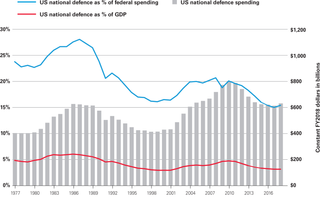
Growing internal pressures within the defence budget
In addition to being squeezed by external fiscal challenges, the defence budget is facing internal pressures that are effectively cannibalising the Pentagon’s purchasing power. Since the 1980s, the funding required for the operation and maintenance of America’s armed forces has grown faster than inflation, while the price of new weapons systems has simultaneously ballooned. Wages and other costs associated with military personnel have also grown. Taken together, these expenses account for approximately 81 per cent of total Department of Defense funding today and represent some of the largest increases in projected future years spending.179 As their rising values are either necessary (in terms of the high healthcare and support costs for military personnel and equipment maintenance) or built into the budget (owing to the increasing complexity of modern military systems) they will continue to place downward pressure on the overall size of the armed forces and the number of new weapons systems that the services can procure and support.180
The largest share of US defence spending goes to operation and maintenance (O&M) accounts, the parts of the budget that fund the Pentagon’s day-to-day activities.181 These funds ensure that everything from tanks to aircraft receive the upkeep they require, that troops are trained and that the Department of Defense receives the services it needs. Yet, parts of O&M have been steadily growing above inflation since the Second World War, including the expansion of the military health system and the sustainment costs of supporting aging equipment. The O&M account as a whole has increased at an average annual rate of 2.7 per cent above inflation since 1948.182 In other words, it has become increasingly expensive to maintain the same sized military force over time.183
Figure 10: Growth of internal accounts within the US defence budget
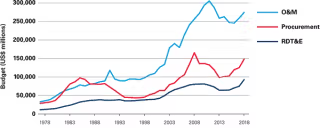
The growth in O&M has squeezed other accounts within the defence budget. At the height of the procurement boom during the Reagan administration, for example, the Pentagon spent more on research and development (R&D) and procurement of military systems than O&M. In FY1985, this amounted to 34 per cent on procurement and 11 per cent on R&D — for a total of 45 per cent of the budget devoted to “modernising” the force — and just 28 per cent for O&M. Today this situation has been reversed. The Pentagon’s FY2017 request put O&M at 42 per cent of the overall defence budget. And while subsequent budgets have sought to divert resources away from O&M following the gradual drawdown of conflicts in Afghanistan, Iraq and Syria, even the FY2020 budget fails to reverse this imbalance between O&M and modernisation. Indeed, O&M now stands at US$292.8 billion (or 41 per cent of the budget) in the Pentagon’s FY2020 request, whereas procurement and R&D together only amount to US$247.4 billion (34 per cent).184
Above inflation rises in civilian pay and fuel prices, and an expansion of military healthcare, have contributed to 60 per cent of the long-term growth in O&M.185 For instance, from 2000-2012, healthcare for military personnel and their families doubled from US$16 billion to US$31 billion, accounting for “roughly 25 per cent of the increase in the O&M budget”.186 Military personnel costs also continue to grow above inflation, and are especially apparent when averaged per service member. In FY2000, the Pentagon budgeted US$72,212 in 2018 dollars per active duty service member when adjusted for inflation, whereas by FY2018 that number had grown to US$107,106.187 This trend is set to continue past FY2020 owing to the rising costs of labour in the wider economy and the fact that it is politically infeasible for Congress to pare back benefits for military personnel.188
Another major source of growth in O&M funding is the higher cost of repairs owing to aging equipment and regular use. Operation accounts include funding for air, sea and land activities, as well as other associated accounts like space and special forces. As budget analyst Todd Harrison has argued, while funding in these accounts grew substantially during the wars in Afghanistan and Iraq, they have failed to return to pre-war levels even as the size of the military declined from FY2013 to FY2017.189 Indeed, the growth in this category has been striking: “On a per plane basis, the Air Force’s cost of air operations is 157 per cent higher in the FY2019 request than it was in FY2000, the Army’s land forces operating cost per active duty soldier is 117 per cent higher and the Navy’s ship operations on a per ship basis is 99 per cent higher (all adjusted for inflation)”.190 Aging equipment that was largely built in the 1980s and the military’s high operational tempo of the past 30 years likely account for these rises. The overall result is a Joint Force that is increasingly more expensive to maintain and operate.
Figure 11: Size of active duty force over time
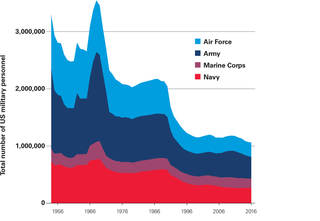
As costs steadily rise, trade-offs within O&M accounts are inevitably made. One has been the acceptance of far greater risk in defence infrastructure and facilities. According to the Pentagon’s own estimates, it has a US$116 billion backlog in infrastructure maintenance across the services owing to the ballooning costs of other O&M expenses.191 Twenty-three per cent of defence facilities are now in “poor condition” with a further 9 per cent labelled “failing”.192 While this occurred at the height of the “readiness crisis”, it is illustrative of a broader “death spiral” at the heart of O&M: The more these accounts grow — due to sustaining old assets, repairing degraded infrastructure and above-inflation growth in benefits, etc. — the less room there is for procurement, research and other necessities. As Harrison warns: “Operations and support costs are going to eat the budget alive”.193
This “death spiral” is compounded by the rising cost of successive generations of new military capabilities.194 As most next-generation weapons systems are far more expensive than their precursors — even when adjusted for inflation — the Pentagon’s ability to buy them in volume is under considerable strain.195 For instance, the F-35 is projected to cost US$64 billion to develop in 2017 dollars, whereas the fighters it is replacing — platforms like the F-18, F-16 and A-10 — had a collective development cost of US$21 billion, also in 2017 dollars.196 But while the Pentagon procured a combined total of more than 4,200 A-10s, F-16s, AV-8Bs and F/A-18s, it plans to only buy 2,457 F-35s as replacements.197 The same trends apply to naval shipbuilding. Since the 1950s, the cost increase of each new generation of amphibious ship, major surface combatant, attack submarine and aircraft carrier has grown from approximately 7 to 11 per cent per generation, exceeding inflation.198 Accordingly, the United States faces the ongoing prospect of ever-rising expenditure for a shrinking force, compelling it to make difficult trade-offs between high-end capabilities and larger numbers of less expensive — and less capable — legacy systems. In the overall context of a constrained budget environment, this declining purchasing power of the US defence dollar places an additional burden on the Pentagon’s efforts to rebuild the Joint Force for great power competition in the Indo-Pacific.
Part 3: An atrophying force
America’s military is not sufficiently ready, equipped or postured to achieve the strategy of conventional deterrence by denial outlined in the National Defense Strategy. Two decades of force development has prioritised counterinsurgency over great power competition, placed unsustainable demands on a shrinking force and cemented a structural bias towards legacy systems and status quo operational concepts. This has left the Joint Force technologically ill-equipped to maintain a favourable balance of power in the Indo-Pacific.
Military readiness has begun to recover, but this improvement has expended budgetary resources and time. Some equipment, like the Joint Strike Fighter, will not reach the readiness goals set out by former Secretary of Defense James Mattis. Other pressures on the military are structural. The Joint Force is not large enough to meet the expansive demands of America’s foreign policy establishment and aging equipment is becoming more difficult and expensive to maintain. Efforts to bring new capabilities online have been hampered by cost over-runs, cancelled in favour of devoting more resources to counterinsurgency campaigns in the Middle East, or delayed in the hope that Congress will appropriate more funding for defence.
Exacerbating these challenges is the fact that China’s military modernisation has successfully focused on negating the technological and operational advantages that the US military has grown accustomed to since the end of the Cold War. Long-range ballistic and cruise missile complexes, in addition to other counter-intervention systems, now threaten American and allied bases and operating locations from Japan to Singapore. These weapons could see China sink or destroy expensive allied warships and aircraft for a fraction of the cost of US power projection. As the majority of America’s forward-deployed air power is concentrated on vulnerable bases within range of Chinese missiles, US aircraft are unlikely to achieve air superiority during a crisis. If unaddressed, this will undercut America’s efforts to blunt Chinese aggression and is likely to be compounded by the fact that US surge forces and logistical support assets are also under resourced and vulnerable to Chinese counter-intervention capabilities.
America’s military services have begun to recognise these challenges and implement changes. But the scale of the problem is vast and will probably outstrip budgetary capacity. New technologies are under development by the Air Force and Navy that may break the vicious cycle of ever-growing costs for next-generation aircraft and warships, while progress on a new generation of munitions with extended ranges is also underway. The Army and Marine Corps are experimenting with novel operational concepts to deter Chinese adventurism. But to achieve this the Joint Force will need to undertake one of its most dramatic reforms in recent history, requiring considerable time, money and persistence. In sum, it is not clear whether the United States will be able to easily turnaround these worrying trends.
Air power in the Indo-Pacific
Air power is a critical component of the conventional balance of power in the Indo-Pacific. For America to deter opportunistic aggression by the Chinese military, the US Air Force and carrier air wings of the Navy must be able to project combat power across the vast geographic distances that characterise the regional security environment. This requires bombers, fighters, aerial refuelling aircraft, and intelligence, surveillance and reconnaissance (ISR) platforms to operate effectively during times of crisis. Beijing’s establishment of sophisticated anti-air and area-denial capabilities, however, means that American air power must develop new ways to surveil, strike and survive in a highly-contested region, and, by extension, hold the elements that comprise China’s anti-access/area-denial (A2/AD) network at risk. Unfortunately, the technological advantages that America developed in the 1970s and 1980s — such as stealth technology and precision strike weapons — are inadequate against Chinese systems that can threaten US aircraft at significant distances. Compounding this challenge is the fact that force development, particularly in the 2000s, did not produce the amount or kind of Air Force and Navy aviation platforms that are likely to be required for conventional deterrence in the Indo-Pacific today. Looking to the 2030s, changes will need to be made to the size, composition and capabilities of America’s air power fleet in order to maintain a favourable balance of power in the region.
The consequences of continuing to deploy a shrinking and aging force
For the past several decades, air power has often been the tool that US presidents have turned to when considering the use of military force. Permissive environments, superior technology and the relatively lower chance of incurring casualties have all been reasons for this heavy use. The United States and its allies have typically achieved total air superiority in these conflicts through the systematic suppression and destruction of enemy fighter aircraft and air defence networks, allowing their own bombers and strike fighters to utilise laser-guided bombs, high sortie rates and mid-flight refuelling in relatively safe environments.199 But this near constant global use of air power for the last three decades has been extremely taxing.200 And an expected slowdown in air operations following the withdrawal from Iraq in 2011 never materialised.201 Highlighting this point, in 2016 the Air Force stated that they had been conducting “26 years of continuous combat operations” and were generating on average 26 strike sorties a day at the height of the conflict in Syria, with an additional 131,000 ISR sorties a year.202

While the United States sustained a near constant use of air power in various military operations throughout the 1990s and 2000s, it also began to downsize its aircraft fleet from Cold War-era highs, and put-off building significant numbers of new air frames to replace them. The Air Force has experienced a 58 per cent decrease in the number of its fighter and bomber squadrons since 1991 and the average age of fighter air frames has grown to 26 years.203 Aging air frames are common across the Air Force in particular, with bombers averaging 42 years, mostly due to the 1960s-era B-52s that are still in use. While the United States has the largest bomber force in the world, only 13 per cent of the fleet — the stealthy B-2 — can penetrate sophisticated A2/AD environments, due to the fact that production was halted at 20 aircraft rather than the 132 originally envisioned in 1992.204 Age also extends to the tanker and refuelling fleet — the backbone of extended and global operations — even as it is the “smallest and oldest it has ever operated”.205 Indeed, the average age of aerial refuelling tankers in the Air Force has now grown to 54 years.206
Air assets that are forward deployed — such as those in US air bases in Japan and South Korea, or air wings stationed on aircraft carriers at sea — are usually well maintained, trained and equipped. These forces are required to be at the highest state of military preparedness as they would be called on first to blunt a Chinese attempt to implement a fait accompli.207 But these air power assets represent a fraction of the force as a whole. Deterioration of military readiness primarily impacts non-deployed forces, like those based in the continental United States.208 As the operational tempo increases and budgets for operations and maintenance are restricted, this often results in a trade-off that disadvantages non-deployed forces, risking their effectiveness if they are required to “surge” into a region in the event of a crisis. Resources are frequently diverted from units that have cycled back to the United States to rearm, retrain and re-equip to forces heading overseas, adding further burden and delay to the cycle. The then-head of US Navy aviation, Vice Admiral Mike Shoemaker, detailed this problem in 2017, stating that in order to equip three carrier strike groups for deployment, he was forced to transfer 94 strike fighters from maintenance depots and other squadrons, cannibalising spare parts from non-deployed fighters and resulting in an overall reduction of naval aviation readiness.209
This cycle — persistent demand on an aging and shrinking force, combined with the impact of across-the-board budget cuts caused by budget sequestration in 2013 — has had a lasting impact on the readiness of key elements of American air power.
This cycle — persistent demand on an aging and shrinking force, combined with the impact of across-the-board budget cuts caused by budget sequestration in 2013 — has had a lasting impact on the readiness of key elements of American air power. This readiness crisis was at its worst from 2015-2017 when senior leaders testified that less than 50 per cent of the Air Force was ready, or “fully mission capable”, to conduct the full-spectrum of combat tasks including nuclear deterrence missions, supporting counterterrorism operations and engaging in potential conflict with a peer adversary.210 Specific air power assets that are key to the conventional balance in the Indo-Pacific were under strain, including fifth generation F-22s and B-2 bombers.211 Over the same period, the Navy’s carrier air wings and strike aircraft were also struggling, with 62 per cent of its F-18s reportedly “out of service” and not ready for combat.212
Since 2017, efforts have been made to arrest the decline in readiness across America’s combat aviation, but some problems still persist. Upon taking office in 2017, then-Secretary of Defense James Mattis identified military readiness as a priority for the FY2018 and FY2019 defence budgets. In September 2018, he ordered the services to reach aviation readiness rates of 80 per cent for the F-35, F-22, F-16 and F-18 by mid-2019.213 Readiness has improved for some of the Air Force’s tactical air power, with the F-16 likely to meet the 80 per cent benchmark in 2019.214 The Navy’s F-18 Super Hornets are also in better shape, with mission capable rates now just below 80 per cent.215 But other high-end platforms, like the F-35, F-22 and F-15 — all essential for deterring a great power conflict with China — have continued to struggle.216 Worryingly, in the most recent public data for FY2018 readiness rates for the Air Force have dipped below 70 per cent for the first time since 2012.217
Aging air frames are also having a structurally negative impact on air power readiness goals. The Air Force’s inventory of F-15s are unlikely to ever achieve desired readiness rates. According to the Pentagon’s FY2020 budget documents, the airframe is suffering from “continuous structural inspections, time-consuming repairs and on-going modernization efforts”, due to the age of the platforms.218 The same issue applies to aerial refuelling tankers. In March 2018, then Commander of the United States Transportation Command testified that the “convergence of an aging air refuelling fleet with protracted KC-46 production” puts the “Joint Force’s ability to effectively execute war plans at risk”.219 Even Naval aviation has seen a steady downward trend in mission capable rates since 1998, owing to equipment operating beyond planned service lives, budget restrictions and delayed modernisation.220
Deferring American air power geared for great power competition
While there are several major modernisation programs underway that will be essential for the future of US air power in the Indo-Pacific, the deferment or cancellation of new capabilities over the last few decades has created what defence analysts call a looming procurement “bow wave” — or, a cumulative build-up of acquisition demands that outstrip budget capacity.221 Two cutting-edge air power programs that were cancelled or truncated because of cost during the last decade illustrate how this situation arose.
One is the Navy’s Unmanned Carrier Launched Aerial Surveillance and Strike (UCLASS) program. In many respects, the UCLASS program represented an early battle within the defence establishment over how the Navy’s air wing should adapt in the face of long-range A2/AD systems like those being deployed by China. Controversy plagued the UCLASS program over its stated requirements, which changed from a vehicle focused on stealth and strike to one that was moderately stealthy and geared more towards endurance and ISR. But cost, rather than function, ultimately became the determinative factor behind these requirement changes, with the director of the Pentagon’s unmanned warfare office confirming that its reduction in strike capability was a “fiscal” decision.222 Throughout its life, the program came under fire from members of the Senate Armed Services Committee, including then-Chairman Senator John McCain, who argued in a 2015 letter to the Pentagon that an unmanned carrier-based aircraft that performed an ISR mission and was unable to operate in contested environments “would be operationally and strategically misguided”.223 Nevertheless, with costs of the program projected to reach US$24 billion, it was deemed that the Navy’s budget would not be able to support it and the procurement of the F-35C at the same time.224 As such, UCLASS became a stealthy carrier-based unmanned aerial refuelling tanker, not the full warfighting capability that some analysts argued was needed to keep the aircraft carrier and its air wing relevant in contested places like the Indo-Pacific.225
Another example of unstrategic decisions to defer modernisation is the truncated production of the F-22 Raptor. The Air Force originally intended to procure a total of 750 air frames as a replacement for the F-15. But after numerous delays, cost overruns and the prioritisation of weapons development for “low-tech” wars in Afghanistan and Iraq, the F-22 program was cut short at 187 Raptors in 2009.226 Protesting the decision, then-head of Air Combat Command General John Corley wrote that “a fleet of 187 F-22s puts the execution of our current national military strategy at high risk in the near- to mid-term”.227 While resources recouped from the program seem to have made space for the B-21 and F-35 programs, the premature end of F-22 production is a revealing example of how even historically high defence budgets throughout the 2000s did not translate to the broad modernisation of American air forces for major power competition.228

Owing to the deferment or truncation of these and other advanced air power systems, a number of new platforms are now entering production at once to create a procurement bow wave. Crucially, the Air Force’s modernisation needs — including the F-35, B-21 Raider, KC-46 aerial refuelling tanker, and space and ISR assets — are the largest contributor to US military’s “overall modernisation bow wave”.229 Several examples indicate the magnitude of this procurement drive. Between FY2015 and FY2023, for instance, projected acquisition programs were set to grow by 73 per cent in real terms, a figure that has largely remained stable in the intervening years. Funding for the B-21 Raider — largely within its projected cost — has grown steadily as the program works up from its design and prototyping phase into production, even as the date of its initial operation has been steadily pushed back into the late 2020s.230 While the first of the KC-46 tankers are now being delivered and operated, the Air Force is not buying them at a rate that will bring the average age of the fleet down.231 Moreover, the F-35 still faces significant acquisition and sustainment costs that, in the context of other modernisation priorities, are restraining the Pentagon’s ability to increase production without major real increases in its defence budget.232 Even with the introduction of 60 F-35As per year — for an overall goal of 1,763 for the Air Force — it is estimated to take 29 years to replace the entire fleet, meaning the average age of America’s tactical fighters will remain close to 30 years indefinitely.233
Compounding all this is a wicked dilemma: As the Pentagon recalibrates American air power for great power competition, it must simultaneously modernise its combat capabilities while building-out its overall size and capacity. Although Air Force and Navy carrier air wings have been judged by some authoritative sources as probably sufficient for a single great power war, significant growth in fighter, bomber and ISR squadrons is required if Washington wishes to plan for a simultaneous regional conflict and keep up its current tempo of global operations.234 Making matters worse, the military-operational challenges now posed by China’s A2/AD capabilities in the Indo-Pacific are causing a rethink about how air power can be effectively used to bolster conventional deterrence and blunt aggression without all-domain dominance. As a demonstration of this operational challenge, roughly 79 per cent of the Air Force’s daily capacity to deliver conventional munitions on a target is “provided by fighters that have less than 1,000 nautical mile unrefueled combat radius”, necessitating innovative concepts and capabilities to improve the endurance, payload capacity, and survivability of aircraft operating in the contested Indo-Pacific theatre.235
Meeting these and other challenges laid out in the NDS will, according to a late 2018 Air Force structure assessment, require a substantial increase in overall size. While it is likely that the Air Force understood there was little chance its requests would be fully funded, it is indicative of the direction the service believes it needs to move. The Air Force identified a need to grow from 312 to 386 operational squadrons, including seven new fighter squadrons, 22 new ISR and command and control squadrons, 14 aerial tanker units and five bomber squadrons.236 Other authoritative assessments have suggested moderate increases to the overall number of air power assets, with RAND and CSBA recommending more bomber, fighter, ISR and aerial refuelling capabilities, in different configurations depending on scenarios and adversaries.237
Yet, independent analysts have questioned the financial viability of expanding the Air Force’s force structure, even though there is general consensus it needs to change. Although the Air Force did not provide costings for its growth plan, budget analyst Todd Harrison estimates that costs associated with acquiring additional aircraft may be as high as US$81 billion in FY2018 dollars, assuming the same squadron mix and formats used by the Air Force today.238 For instance, an additional 14 squadrons of aerial refuelling tankers would cost upwards of US$33 billion, and another US$28 billion for five new squadrons of the B-21 Raider.239 The cost to sustain, operate and maintain these assets — including associated personnel and fuel costs — could be even more financially burdensome, with some estimates putting the figure at US$18 billion a year, or US$90 billion over five years.240 This would represent an increase of almost 15 per cent to the Air Force’s budget — something unlikely to be achieved under current fiscal conditions.241
A slow crisis: American naval power in the Indo-Pacific
America’s ability to project maritime power across the Indo-Pacific and maintain an effective forward-deployed warfighting presence are critical elements to sustaining a favourable balance of power. In contrast to air and land forces — which are concentrated in large operating bases that are highly vulnerable to Chinese missile attacks — US Navy forces are mobile when not in port and relatively more capable of self-defence. This can permit at least some naval assets to “remain near the adversary’s objective” in order to prevent, delay or blunt aggression.242 Nevertheless, China has exploited its strategic depth as a large land power and developed a range of strike capabilities that can threaten naval forces within the First and Second Island Chains. It has also invested in thoroughly modernising the People’s Liberation Army-Navy (PLA-N) by replacing aging Soviet-era designs with predominantly modern surface and subsurface forces. This provides a credible threat to American dominance at sea, a scenario that the US Navy has not prepared for since the Cold War.243 Crucially, the United States has been relatively slow to respond to these operational and strategic challenges in terms of altering capability, size and composition of the Navy.244
Draining the fleet through overuse
As with American air power over the past two decades, the operational tempo of the US Navy has been relentless, taking a serious toll on ship maintenance, crews and training, particularly in the Indo-Pacific. Since 1987, the Navy has experienced a 52 per cent decrease in its total number of vessels, falling from a high of 594 ships to just 290 today.245 Although the size of the fleet has decreased, the number of ships deployed overseas — approximately 100 at any one time — has not, meaning “each ship is deployed more to maintain the same level of presence”.246 In February 2018, Vice Chief of Naval Operations Admiral William F. Moran testified that during the apex of the Cold War, “approximately one in six ships were deployed on any given day”. In 2018, this ratio was now “almost one in three” creating a “math problem that clearly demonstrates that national demands for your Navy far exceed its capacity”.247 As this ratio has become worse, the Navy has compensated by extending deployment times for aircraft carriers, cruisers, destroyers and amphibious ships from seven to nine months on average.248
Extending deployment times has had the effect of decreasing the amount of time available for training and increasing the overall requirements for maintenance. Meanwhile, the impact of broader defence budget instability on operations and maintenance funding for the Navy has further exacerbated this problem.249 The cumulative impact has been a growing backlog of maintenance that has prevented some vessels from deploying. A GAO report in 2018 estimated that only 30 per cent of ship maintenance has been completed on time since FY2012.250 Senior leaders from the Navy have estimated that the maintenance backlog grew from “4.7 million man-days to 5.3 million man-days between 2011 and 2017”.251
|
The submarine maintenance backlog The most concerning example of blow-outs in maintenance times has been the case of the Navy’s nuclear attack submarines. The GAO found that since FY2008 “14 attack submarines have spent a combined 61 months (1,891 days) idling waiting to enter shipyards for maintenance”, costing the Navy an estimated US$1.5 billion for no operational return.[^252] The most egregious example the GAO found was that of the USS Boise, a Los Angeles-class nuclear attack submarine, which was scheduled to enter maintenance in 2013 but has been idling pier-side since 2016.[^253] |
The tempo of operations and strain on the fleet have also impacted training and effectiveness, sometimes with tragic results. Since 2013, there has been a notable rise in military accidents, including in the US Pacific Fleet’s area of operations. A review into the collisions affecting the USS Fitzgerald and USS John S. McCain in 2017, which collectively resulted in the deaths of 17 sailors, found “increased deployment lengths, shortened training periods and reduced or deferred maintenance to meet high operational demands” had resulted in poor readiness of forward deployed naval forces.254 The Navy’s own assessment stated that the demand for ships in Indo-Pacific Command’s area of operations “ultimately exceeded the quantity that could be generated” from forward deployed forces in Japan, resulting in a gradual degradation of readiness as Navy leadership tried to keep up the unsustainable operational pace.255
Growing demand for naval power and the Pentagon’s renewed focus on great power competition has resulted in broad agreement that the Navy should grow larger. The logic is that a larger fleet would serve to maintain the Navy’s global forward-deployed presence and provide it with adequate capacity to fight one major war while deterring “opportunistic aggression elsewhere”.256 In 2016, the Navy released a revised fleet plan that called for 355 ships — an increase from the previous goal of 308 — with additional large surface combatants, nuclear attack submarines, amphibious landing ships and another aircraft carrier.257 Yet, although the Trump administration has made naval fleet growth a signature policy, the ability of the defence budget to support the cost of additional naval construction and the associated support and operating expenses is increasingly questionable.
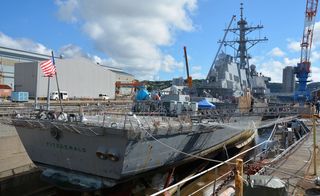
In 2017, the Congressional Budget Office (CBO) estimated that achieving a 355-ship Navy in a 30-year timeframe would cost “an average of $26.6 billion (in 2017 dollars) annually for ship construction”, or 60 per cent more than the average levels of funding Congress has appropriated over the past 30 years.258 The Navy’s latest report on naval construction largely supports this assessment, forecasting that US$26-28 billion will be needed per year beyond FY2024 to reach the 355 ship goal by FY2034.259 Part of this increase is due to an ongoing trend in the rise of naval shipbuilding costs, which has grown by an average of 7 to 11 per cent annually for the past 50 years, exceeding the rate of inflation.260 This is largely due to the rising complexity of modern naval vessels, a trend that is unlikely to abate for new manned ship construction.261
Crucially, most of the cost in new ship construction is not the vessels themselves, but in their ongoing sustainment. If the 355-ship fleet goal were to be reached, operating expenses would be huge. According to CBO estimates, by 2047 the annual cost of operating 355 ships would be US$94 billion, or 67 per cent more than a fleet size of 275 ships.262 Further, these estimates are still largely guesswork, with Navy officials recently stating that they have yet to develop the “complex modelling” needed to cost the total sustainment of 355-ships.263
While construction and sustainment costs are increasing, one method the Navy is pursuing to increase its capacity is to extend the life of its surface fleet. In 2018, Navy officials announced the service life extension of all DDG-51 destroyers from their designed 35-year lifespan to 45 years, in an effort to boost fleet numbers through the 2030s.264 This class-wide extension was cited by the Navy as one of the “principle drivers” of its accelerated projections in reaching 355 ships by FY2034.265 The downside of this approach is that while the Navy will achieve its 355-ship goal faster it will be the wrong mix of ships — leaving the fleet “too top-heavy” with excess large surface combatants, and “not enough small combatants” to distribute its offensive power in order to more effectively confront China’s A2/AD networks.266
The life extension of the Navy’s largest surface combatant, the Ticonderoga-class cruiser, has also been a factor in its struggle to simultaneously increase size and sophistication of the fleet. America’s 22 Ticonderogas provide a core element of the Navy’s carrier strike groups. Each are equipped with 122 vertical launch system cells — 26 more than the latest Arleigh Burke destroyers — that can be deployed with a mix of missile defence and surface attack munitions. While the Navy planned to push the ships past their 35-year designed lifespan, the service is now considering cancelling six of the extension plans by 2022 as a cost saving measure.267 There are plans to replace the retiring Ticonderogas with a follow-on large surface combatant — potentially unmanned — but the timeframe for acquisition has extended from 2023 to at least 2025.268
Figure 12: US Navy attack submarine force projections
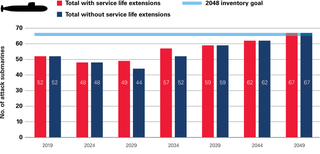
Falling levels of nuclear attack submarines: A critical conventional deterrence gap
A complicating factor in the Navy’s struggle with expanding the size of the fleet is the declining stock of nuclear attack submarines (SSN), one of its critical advantages in the Indo-Pacific. America’s SSN fleet consists of the retiring Los Angeles-class, the new Virginia-class, converted Ohio-class guided missile submarines (SSGNs), and the three late Cold War-era Seawolf-class SSNs. Nuclear attack submarines are a vital asymmetric advantage for the US military: They are difficult to detect, can more easily penetrate contested environments and can provide ISR as well as offensive strike options against subsurface, surface and land targets.269 Put simply, as the environment above the surface becomes more deadly because of Chinese deployments of cruise missiles, hypersonic technologies and anti-air defences, America’s enduring advantage in undersea warfare will become increasingly important in the regional balance of power. This is already apparent in the high demand for SSNs by combatant commanders, which often outstrips platform availability. Indeed, Indo-Pacific Command only receives “slightly over 50 per cent” of its day-to-day SSN requirements.270
Alarmingly, the Navy’s overall stock of SSNs is set to decrease over the next decade as older Los Angeles-class boats are retired faster than new Virginia’s are built — largely due to a draw-down in submarine construction in the early 1990s. From the mid-2020s through early 2030s, the number of SSNs will dip to a low of 42 boats — or 24 boats less than the Navy’s 66-boat goal — before growing again.271 Although over half of the Navy’s SSN fleet is currently stationed or deployed in the Indo-Pacific, this fall in numbers is likely to increase the overall global demand on a shrinking force.272 Recent attempts to boost SSN construction to compensate for the drop through the mid-2020s are not likely to result in a significant increase in SSN numbers during the 2020s, owing to high costs, the need to begin construction on new Columbia-class SSBNs and the limited number of naval shipyards equipped to build nuclear-powered submarines.273
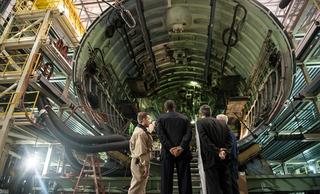
Moving from an efficient to an effective fleet
The future of American sea power in the Indo-Pacific depends on the Navy’s ability shift from a force that is “efficient” to one that is more “effective”.274 At present, there is a tendency to utilise large, high-end surface combatants, such as aircraft carriers, to respond to the entire range of naval missions globally. Although this has been an effective warfighting approach against rogue states like Iraq, it is both inefficient and ineffective against modern counter-intervention networks.275 The Navy has developed the concept of “Distributed Lethality” as one solution to this problem, which envisages a large number of platforms dispersed over an expansive geographic area each with its own offensive and defensive capabilities.276 To realise this vision, however, requires serious investment in new surface and subsurface unmanned platforms, smaller manned surface combatants and modernisation of certain existing vessels to ensure they are equipped with cost-efficient defensive and offensive systems.
More broadly, American sea power needs to become more advanced, develop new concepts of operations and pioneer new technologies along several fronts in order to maintain conventional deterrence in the Indo-Pacific. A key operational problem the Navy is trying to solve is finding new ways to disrupt the advantage that China’s air and missile systems have against US surface ships. Owing to the sophistication and number of missiles the PLA may use to threaten America’s surface combatants, these warships are forced to carry a growing number of defensive munitions leaving them with less capacity for offensive operations against surface targets.277 This dynamic makes US naval forces less effective and efficient. High-powered lasers and next-generation ballistic and projectile weapons are being considered to bolster America’s sea-based missile defences in order to free up missile capacity for ship-based offensive weapons.278 Similarly, electronic warfare systems are also being considered for crucial roles in adding another protective layer for surface ships, providing passive unmanned decoys as well as assisting in offensive strike operations.279 Other sea power effects relevant to the Indo-Pacific that require modernisation, innovation and restructuring include the Navy’s mine warfare, strategic anti-submarine warfare and subsurface operations, much of which was set-back by the failure of the Littoral Combat Ship program.280
Figure 13: US Navy and PLA-Navy attack submarine inventories
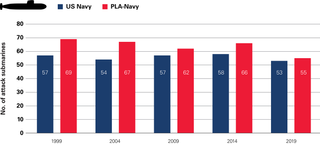
A new role for the US Army and Marine Corps in the Indo-Pacific
Land, or the many islands and archipelagos of the First and Second Island Chains, will play an increasingly critical role in facilitating America’s warfighting edge in the Indo-Pacific power balance. Since the Obama administration’s “Rebalance to Asia”, US land-based forces in the region have primarily focused on building capacity and networks with local partners through innovative initiatives like Pacific Pathways.281 Given that militaries in the region are typically dominated by their land-based components, the US Army and US Marine Corps have transitioned units throughout the region for defence diplomacy and training, conducting exercises with key allies, like Australia and South Korea, and partners such as Nepal, Vietnam, Mongolia and Malaysia. But the role of American land forces in the Indo-Pacific is beginning to shift. Following Washington’s withdrawal from the Intermediate Nuclear Forces Treaty (INF) in 2019, the Pentagon is developing new operational concepts and conventional capabilities that utilise long-range land-based strike as a means of sharpening its ability to blunt a Chinese fait accompli strategy.282 These capabilities will be crucial in improving the cost-effectiveness of US and allied forces in maintaining a favourable balance of power in the region.
The Army and Marine Corps are entering a period of transformation following nearly 20 years of sustained counterinsurgency operations. Ideally, with a return to great power competition, US land forces should reduce their overall size, using the savings to refocus on developing high-end and technologically advanced capabilities. Indeed, a modern and agile force structure could be better suited to deterring conflict in the islands of the Western Pacific where American troops would utilise pre-positioned equipment to quickly respond to Chinese aggression.283 However, overall capacity demands on the Army in particular have not abated due to the fact that day-to-day deployments in Afghanistan, Europe and elsewhere continue at a high pace.284 As a result, readiness issues continue to plague US ground forces despite showing some signs of improvement since the crisis of 2015-2017.285 In 2018, then-Army Chief of Staff General Mark Milley testified that the Army’s internal goal is to have 66 per cent of its Brigade Combat Teams (BCT) ready at all times, but it is only “in the range of the 50 per cent mark”, with 15 of 31 BCTs “ready” and, of those, only eight fully equipped, trained, and manned for a great power conflict.286
The US Army and Marine Corps are entering a period of transformation following nearly 20 years of sustained counterinsurgency operations.
The US Army is seriously pursuing modernisation. Compared to the Air Force, the Army has relatively “young” equipment, with much of its mechanised forces replaced for the counterinsurgency campaigns of the 2000s. Yet, many of these systems were designed and developed in the 1970s and 1980s — albeit with upgrades over time — or, in the case of new acquisitions like the improvised explosive device resistant “MRAP” vehicle, are ill-suited for major state-on-state conflict.287 This is partly due to a “lost” generation of modernisation in the 2000s, when many next-generation programs, like the Future Combat System, were cancelled.288 Indeed, between 1995 and 2010, at least 22 modernisation programs were called off, effectively squandering US$32 billion in funding.289 According to a 2017 report into Army modernisation, between 2004 and 2009 the service spent 36 to 42 per cent of its research and development funds on programs that never materialised.290 The consequence of all this waste has been an incremental upgrading of Army systems rather than a generational “transformation” as envisioned in the early 2000s. While next-generation capabilities are now under development, many are not slated to enter full production until at least 2023.291

The Army’s readiness and modernisation imperatives have challenged efforts to align its force structure with NDS requirements. Its intention in FY2019 was to grow the end strength of the active force to 487,500 personnel. Nevertheless, the Army failed in its recruiting and retention targets, ending 2018 with 478,000 active troops.292 While its aim was to reach 495,000 personnel by 2021, recruitment goals have now been sensibly downgraded to add 2,000 troops in FY2020 rather than a previously projected 4,000 a year.293 This is more in line with the NDS’ focus on prioritising capability over capacity. Notably, a major point of success has been the streamlining of development and modernisation programs through a “night court” process, resulting in the cancellation of 186 minor programs to free up US$33 billion for more strategic investment.294 Broadly, these cost savings have been redirected to the “Big Six” programs the Army expects will be critical for great power competition: Long-range precision fires, next-generation combat vehicles, future vertical lift, combat networks, short-range air and missile defence, and soldier lethality.295 For US land forces in the Indo-Pacific, two of these capabilities — long-range precision fires and missile defence — will play important roles in bolstering conventional deterrence.
New capabilities and operational concepts
The role of land-based forces in denying PLA power projection and providing mobile offensive fires that can hold elements of China’s counter-intervention capabilities at risk is growing. At present, America’s offensive strike capabilities are mostly based on sea- and air-based platforms. This is a two-sided cost for the US military: It limits the payload capacity that US forces can bring to bear in a conventional conflict and it increases pressure on the overall defence budget, due to the high cost of these generally exquisite platforms.296 Accordingly, the Department of Defense has recognised the need for a land-based, mobile and cheaper offensive fires capability, as well as more cost-effective missile defences for regional bases. These, along with new and more effective operational concepts, are intended to deny Chinese aggression from positions along the First and Second Island Chains.297
Building an allied version of China’s own counter-intervention network in the region would present a multi-domain challenge to air, land and sea-based PLA forces, particularly as they become more reliant on long-range sensors for the precision targeting of munitions.298 According to a major RAND study, the deployment of anti-ship cruise missiles along the First Island Chain would “have a significant effect on China’s ability to project power” by cutting off sea routes and “vastly” expanding the set of “military problems” that the PLA would face.299 Specifically, a larger set of targets would stress the PLA’s command and control systems rather than allowing concentration on a “few well defined targets”, namely large US military bases like those on Okinawa or Guam.300 A similar study by CSBA analysed the role that American land forces could play in providing multi-domain fires, arguing that Army forces in the Indo-Pacific could “provide a form of overwatch” that would enable naval and air platforms to project power “more effectively”.301
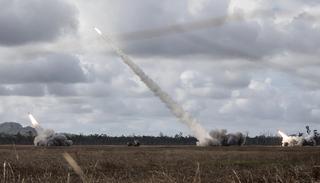
Following the United States’ withdrawal from the INF Treaty this year, the Army and Marine Corps have begun to work on new land-based offensive fires and missile defence capabilities, with intended deployment in the Indo-Pacific. In the administration’s FY2020 defence budget request, three new ground-launched missile systems were flagged: A ground launched ballistic missile system, a mobile cruise missile that will likely be a version of the existing Tomahawk, and another mobile, land-based medium-range cruise missile.302 In all, the requested budget for these systems in FY2020 totals US$100 million, though the Army has projected funding could grow to US$900 million by FY2024.303 While it may take years before these systems are ready for production, near-term solutions are being explored, like giving the High Mobility Artillery Rocket System (HIMARS) an anti-ship role by adapting the Naval Strike Missile.304 The Army is also experimenting with new integrated missile defence, with a focus on negating cruise missile attacks.305 Two Israeli Iron Dome systems were purchased by the Army in early 2019 for testing and evaluation, a battery of highly mobile short-range air defence systems based on the Stryker armoured vehicle is due to enter service in 2020, and technologies like high powered lasers and advanced projectiles are receiving greater research budgets.306
In addition to technology development, the Army and Marine Corps are forging ahead with developing innovative operational concepts utilising long-range precision fires and mobile launchers, with a focus on re-establishing sea-control in contested environments like the Indo-Pacific. In late 2019, the Marine Corps Warfighting Lab has planned a “massive sea control experiment and exercise” that will use “long-range ground-based anti-ship missiles” to further its new Expeditionary Advance Base Operations concept, which envisions Marine units spreading out over islands and small beach pockets to temporarily secure air and sea space.307 The 2019 Marine Commandant’s Planning Guidance — which aims to align the Marine Corps with the NDS — also calls for radical changes in how the service will operate in the near future. Recognising that great power competition will demand much of US naval forces, the Marine Corps “will be trained and equipped as a naval expeditionary force-in-readiness and prepared to operate inside actively contested maritime spaces in support of fleet operations”.308 The Guidance also calls for dispersed operations, a focus on experimentation and the implementation of its new operating concepts.309 In parallel, the Army has formed its first Multi-Domain Task Force that includes combining “intelligence-gathering, long-range attack and the ability to manoeuvre from island to island across the vast Pacific”.310 In 2017, US Army Forces Pacific was named as the lead organisation for the new concept; and over the past two years it has held exercises across the region — sometimes in conjunction with allies like Japan — to implement and experiment with multi-domain effects, including long-range precision fires.311
Supporting a strategy of conventional deterrence by denial
The Indo-Pacific presents unique geographical challenges for America. Owing to its significant distance from the continental United States, adequate infrastructure, logistics, sealift and networking capacities are crucial to ensuring warfighting effectiveness and credible conventional deterrence. Towards the end of the Cold War, significant efforts were made by NATO to harden air bases and disperse forces across Europe, as well as to demonstrate the ability to quickly mobilise and transport large quantities of military assets and materiel across the Atlantic in a crisis. Similar efforts now need to be made in the Indo-Pacific. Again, however, this task is complicated by China’s conventional missile capabilities which threaten the maritime logistics supply lines and open-air basing model which the US military has employed for decades.312 Inadequate resourcing for military construction and America’s naval and merchant fleets has compounded this problem.
Hardened bases vs. precision strike
The lack of hardened bases, airstrips and related infrastructure poses a particular challenge for American power projection in the Indo-Pacific. In conflicts from the Balkans to Iraq over the past several decades, the United States has had the luxury of bringing overwhelming numbers of aircraft to nearby bases from which they could undertake combat operations with relative impunity. The concentration of personnel and materiel at these forward locations allowed for a substantial degree of logistical efficiency, resulting in high sortie rates by tactical fighters and a consistent delivery of large numbers of precision weapons. The success of air campaigns in Operation Desert Storm in 1991 or Operation Allied Force over Yugoslavia in 1999 were contingent on the safe and effective mobilisation of forces in airbases such as Aviano in Italy or Shaikh Isa Air Base in Bahrain.313

This model of operations is not possible in the Indo-Pacific today as China has exposed the vulnerability of forward concentrated basing.314 According to some analyses, coordinated attacks by PLA ballistic and cruise missiles on American air bases could destroy “up to 70 per cent” of their aircraft in the opening stages of a conflict.315 Others have described the damage to runways, maintenance facilities and associated infrastructure that would prevent their use for over a week in certain combat conditions.316 As air bases close to potential areas of conflict, such as the Taiwan Strait, have come under threat, mastering the vast distances of the Pacific Ocean has become a greater factor in America’s ability to efficiently project military power. Only two air bases — both on Okinawa in the Ryukyu Islands archipelago — are located within the 1,000km unrefuelled range of US tactical fighters from the Taiwan Strait. For American land-based air forces to reach the Strait, they would have to operate at longer ranges and rely on vulnerable air-to-air refuelling “that would substantially reduce the sortie generation rate and on-station time of the aircraft employed”.317
Coordinated attacks by PLA ballistic and cruise missiles on American air bases could destroy “up to 70 per cent” of forward-based aircraft in the opening stages of a conflict.
One way to offset this growing challenge is to selectively harden runways, aircraft shelters and other supporting regional infrastructure. As the threat to US basing has grown, military leaders and defence strategists have repeatedly testified on the need to invest in military construction and the hardening of facilities.318 But the United States has lagged in building resiliency across its bases in the Indo-Pacific. According to a 2014 estimate, the US military had only 207 hardened aircraft shelters across four bases in the Western Pacific, with most located in South Korea — an increase of just 2.5 per cent over the previous 12 years.319 The Air Force has 15 hardened shelters at Kadena Air Force Base on Okinawa; all other bases are either unhardened or shared with allies and partners that may not allow access to their facilities during a US-China conflict.320 If a major conflict broke out today, the Air Force could operate up to 190 aircraft from Kadena, the vast majority of which would be “parked in the open”.321 By comparison, between 2000 and 2012, China — which has 39 air bases within 800km range of Taipei — grew its hardened aircraft shelters from 92 to 312, representing an increase of nearly 240 per cent.322
The cost of hardening regional air bases is rapidly rising. As precision weapons have become more accurate, the construction and materials necessary to negate their effect are getting more costly. Aircraft shelters with “nine-foot-thick walls and 12-foot thick roofs constructed of high-strength concrete” are now necessary to defeat the penetrating warheads on modern conventional ballistic and cruise missiles.323 For a 12-aircraft hardened shelter, current cost estimates range from US$690-$920 million, totalling up to US$1.5 billion for sufficient shelters at a single air base.324 For example, the estimated investment in hardened base infrastructure in Saudi Arabia ahead of the First Gulf War — where the United States contributed to building the world’s most advanced above ground hardened shelters — was US$40 billion. Even then, a significant number of aircraft were forced to park in the open.325 This raises questions about the feasibility of base hardening, for both US and Chinese forces, relative to the offensive capability of precision missiles.
The decline of US wartime logistics
Credible conventional deterrence by denial rests on the ability of a defender to blunt aggression on the frontline and then surge war-winning forces forward to tilt the balance. This was a cornerstone of US and NATO credibility in the Cold War, which was centred on the sealift capacity to transport troops and materiel quickly across the Atlantic. In the larger and more complex Indo-Pacific area of operations, the United States and its regional allies would struggle to quickly deploy surge forces or resupply forward-based units over vast maritime distances.326 The inability to adequately support US and allied forces in theatre would constrain the types of operations and joint-manoeuvres that could be employed to blunt and respond to Chinese aggression.327 Sea and air lift capabilities are also particularly vulnerable to attack and disruption, as some of these assets rely on civilian networks and platforms during a crisis.328
A huge amount of materiel would need to be transported across the Pacific in the event of a regional conflict. One recent study estimated that, historically, 90 per cent of the cargo needed by forward deployed US forces has been transported by sea.329 Over the course of a month in a conflict with China, American warships and fighter aircraft could consume up to 14 tanker loads of fuel, more than 10,000 Vertical Launch System munitions and 10,000 tons of other expendables.330 While these figures are potentially inflated, as it is unlikely the Joint Force would be conducting continuous combat operations, they are illustrative of the logistical challenge presented by modern state-on-state conflict. This is compounded by the sheer distance that American supplies would have to travel: To sail from Pearl Harbour to East Asia takes 10 steaming days at 20 kt, while from Honolulu to the middle of the Indian Ocean would take “nearly 21 days at the same speed”.331
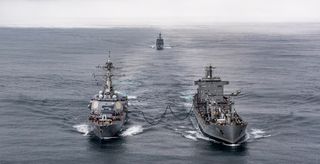
The United States will need to continue to invest in and modernise its sealift capacity to maintain a credible deterrent. Elements of the fleet — which includes both civilian and military vessels — are currently underfunded and failing to keep up with the modernisation efforts in the overall Navy. The civilian element of the reserve fleet that would be activated during a conflict has shrunk considerably from 199 US-flagged vessels in 1990 to only 82 by 2017.332 Ensuring there is an adequate number of sailors to crew the fleet is another concern, with government assessments estimating a shortfall of 1,800 personnel “in the event of a sustained military activation”.333 Once again, the vessels that would be brought to bear in a crisis are mostly operating beyond their designed service lives, with the average age of the Ready Reserve Force at 44-years compared to a roughly 19-year mean in the commercial sector.334
|
The inadequacy of US sealift and logistics America faces a present and future need for a significantly larger military-designated sealift and logistics capacity, which current naval shipbuilding plans do not account for. The US Navy has 23 refuelling vessels and 12 cargo and munitions vessels of various sizes and classes. A recent study projected these two classes on their own would need to grow to 69 and 25 respectively to fulfil the aims of the National Defense Strategy.[^335] To reach this goal, the portions of the naval shipbuilding budgets dedicated to these types of capabilities would need to increase. During other periods of great power competition, the budget dedicated to logistic shipbuilding rose to almost 4 per cent of the total naval shipbuilding budget. At present, it will only reach 1.95 per cent over the next 30-year naval shipbuilding plan.[^336] |
Payloads over platforms
While new military platforms, like unmanned vehicles and submarines, are critical to the evolving balance of power in the Indo-Pacific, the payloads they will carry are equally important. By and large, the present generation of US and allied munitions lack the range to penetrate China’s A2/AD networks without aircraft or surface vessels placing themselves at significant risk. In some cases, China has made strides in developing new classes of munitions that the United States has abrogated since the end of the Cold War, notably in naval strike weapons and over-the-horizon air-to-air missiles.337 This disadvantage extends across the Joint Force. American naval vessels do not have the strike power needed to confront PLAN warships on the open sea, while the Air Force lacks stealthy, long-range missiles for land, air and maritime strike roles. Disadvantages in offensive munitions are compounded by the need for sufficient and war-time credible inventories that are stockpiled in the region.338 A conventional conflict with China will demand huge numbers of torpedos, sonobuoys and precision missiles of various types, many of which cannot be assembled quickly.
As the limits of current munitions stocks and capabilities have become apparent, efforts to provide US and allied forces with longer-range and more sophisticated stand-off weapons have quickened. Such activity began in 2012 with the establishment of the Strategic Capabilities Office, a pillar of the “Third Offset Strategy”, which championed efforts to modify and add naval strike capabilities to the Tomahawk cruise missile and the Standard Missile-6.339 These modifications were achieved relatively simply and cheaply through software fixes.340 Recently, the services also have begun looking outside their traditional defence suppliers for new munitions. The Norwegian designed and manufactured Naval Strike Missile (NSM), an over-the-horizon capability with a range of over 100nm, was recently selected by the US Navy to begin integration across its air and surface forces, with potential application onboard submarines as well.341 The Marine Corps has selected the NSM for a land-based sea-control capability that can be utilised from islands in the Indo-Pacific.342
These capabilities provide near-term options while a new generation of munitions is entering into development. The new Joint Air-to-Surface Standoff Missile-Extended Range (JASSM-ER), entering production in 2021, aims to further the range of this missile from 200nm to over 500nm, as well as adding the ability to operate in GPS denied environments.343 The Air Force intends to integrate the missile on all of its platforms; for now, initial certification has been completed on the B-1 bomber, enabling it to carry 24 JASSM-ERs and making it a critical offensive platform in the Indo-Pacific.344 The Long-Range Anti-Ship Missile (LRASM), a derivative of the JASSM, is also under development with planned deployment with the US Navy and potentially to Australia.345 Two new long-range missiles designed to counter A2/AD capabilities are also set to enter design and production in the early 2020s. The first, the Advanced Anti-Radiation Guided Missile-Extended Range, is being modified by the US Air Force into a stand-off weapon that will specifically target “theatre ballistic missile launchers, land attack and anti-ship cruise missile launchers, GPS jammers, anti-satellite systems and integrated air defense systems”.346 The second is the next-generation beyond visual range air-to-air missile, the AIM-260.347 The US Air Force is developing the weapon as a counter to the PLA-designed PL-15, an advanced long-range air-to-air missile equipped with its own active electronically-scanned radar array.348
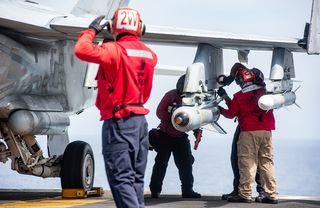
Even with the next-generation of long-range munitions well under way, ensuring a sufficient inventory on hand and forward-deployed to the region remains a problem for US Indo-Pacific Command.349 Its commanders have repeatedly testified on the need for greater stockpiles of munitions in the region as a preparatory measure for high-end conflict.350 The Pentagon’s recently released Indo-Pacific Strategy Report describes the need for more than 400 Advanced Medium-Range Air-to-Air Missiles, an equal number of Joint Air-Surface Missiles-Extended Range, and additional Long Range Anti-Ship Missiles and Maritime Strike Tactical Tomahawks.351 These needs largely follow the requests made in the Pentagon’s FY2020 budget, although even if appropriated by Congress it is not clear if these munitions would be stockpiled in, or dedicated to, the Indo-Pacific region.352
Part 4: Recommendations for collective defence
The state of the US military and its questionable ability to execute a strategy of conventional deterrence in the Indo-Pacific should be of grave concern to policymakers in Australia and other like-minded countries. Owing to Washington’s global problem of strategic insolvency, and the political, economic and internal pressures that are continuing to constrain its defence budget, efforts to improve America’s overall military position in the region will remain difficult, precarious and time-consuming.
This is not to say that the United States has become a paper tiger. The Pentagon still presides over the world’s most powerful — albeit overstretched — military and is endeavouring to recalibrate its capabilities, posture and operational concepts for a new era of great power competition. Given the hardening consensus in Washington that Beijing poses a strategic threat, the United States is likely to continue supplying the central elements of any military counterweight to China in the region. Its ability to single-handedly maintain a favourable balance of power, however, faces mounting and ultimately insurmountable challenges.
Washington will require significant and ongoing support from its regional allies and partners to successfully deter Chinese adventurism and shore-up a stable strategic order in the Indo-Pacific. This uncomfortable fact is now openly recognised at senior levels of the US defence establishment. As the Pentagon’s Indo-Pacific Strategy Report puts it: “The challenges we face in the Indo-Pacific extend beyond what any single country can address alone”.353 Former Deputy Assistant Secretary of Defense Elbridge Colby has been even blunter, telling the Senate Armed Services Committee in January that: “We need allies and partners to contribute real military capability ... to deterring China [directly]”.354
Collective defence is fast becoming a necessity as a way of offsetting shortfalls in America’s regional military power and holding the line against rising Chinese strength. It is in Australia’s strategic interests to advance this defensive strategy.
A strategy of collective defence is fast becoming a necessity as a way of offsetting shortfalls in America’s regional military power and holding the line against rising Chinese strength. Such a strategy would see middle powers with capable militaries — such as Australia and Japan — work alongside the United States and vulnerable regional partners to strengthen deterrence in strategically critical flashpoints like Taiwan, the East China Sea, maritime Southeast Asia and the Pacific.355 The objective would be to aggregate military capabilities and align operational concepts and strategy in order to present a more credible approach to blunting Chinese aggression and minimising its strategic expansion.
Australia has deep national interests in contributing to a strategy of collective regional defence. Although far removed from tensions along the First Island Chain, Australia’s freedom of action and ability to evade military coercion are ultimately linked to the preservation of a stable balance of power and a regional order that is not dominated by China. Were America’s relative decline to precipitate a Chinese fait accompli, the ensuing conflict, strategic shifts or weakening of US alliances and partnerships would jeopardise the order on which Australia’s security depends. Contributing to a regional balancing coalition designed to prevent this eventuality by deterring conflict in the first place is, for Canberra, the next best strategic policy option in the wake of America’s now defunct uncontested military primacy.
This strategy would fundamentally alter Australia’s strategic identity from that of a security contributor to frontline ally. Although it is defensive in nature it is not without risks. Joining a collective approach to deterrence and warfighting would place Australia into a more adversarial relationship with China, with the potential for severe consequences in a crisis. And as successful collective defence would hinge on America’s ability and willingness to underwrite a military balancing coalition, appraising Washington’s capabilities and intentions accurately will be of paramount importance. Canberra, in any case, should carefully weigh its interests in any contingency to determine whether it is prudent to take part in collective military action. Furthermore, given the ongoing uncertainty about American military power in the region, Australia should simultaneously prepare for a more unstable future in which the Australian Defence Force may be required to provide large-scale independent strategic effects to secure its vital national interests.
But the overall logic of a collective balancing strategy in which like-minded nations pull together to uphold a favourable balance of power makes strategic sense for a middle power like Australia. It is far preferable to an alternative future in which the spectre of American decline causes regional allies and partners to defect from common defence objectives. With the above caveats in mind, Australia should work towards advancing a strategy of collective defence through the following recommendations.
1. Pursue capability aggregation and collective deterrence in the Indo-Pacific with regional allies and partners
Prudent capability aggregation between the armed forces of Australia, Japan and the United States will be critical to addressing the shortfalls that America is likely to face in its military power over the coming years. The strategic purpose of such efforts should be to strengthen the collective capacity to deter prospective Chinese fait accompli aggression in strategically significant regional flashpoints, particularly along the First Island Chain and in the South China Sea. This will require a step-change in Australia’s operational and strategic planning. Canberra would need to plan and credibly demonstrate a willingness to use its sophisticated and high-end capabilities — in combination with other like-minded partners — to deny, disrupt and destroy the forces of a highly-capable aggressor in the absence of all-domain dominance. Such an approach necessitates careful thinking about the political, legal and military criteria that would need to be met for Australia to be able to aggregate its capabilities with other militaries in a cohesive and operationally useful way.
Australia and Japan have credible roles to play in an Indo-Pacific collective balancing strategy. For capability aggregation to work, the United States must fully “read in” allies like Australia and Japan, starting with more integrated intelligence sharing and evolving towards regional operational military planning. Establishing pathways towards joint operational directives are necessary building blocks for an effective denial strategy, as knowing how multi-national forces will be employed in peacetime and war is critical to the reliability of the collective deterrent. This was common during the Cold War, where joint planning in specific mission areas eventually informed allies’ force development. Examples included Japan’s contribution to America’s anti-submarine warfare (ASW) strategy against Soviet submarines in the Sea of Japan, and its Maritime Self Defence Forces (JMSDFs) planned role in protecting US air bases from Soviet attack in order to free-up American forces to focus on offensive operations.356 As Tokyo and Canberra continue to modernise their militaries over the next decade, they will maintain — and in some cases, expand — their collective inventory of assets in several crucial areas: Attack submarines, anti-submarine warfare assets and principal surface combatants.
Figure 14: Aggregated US, Australian and Japanese capabilities
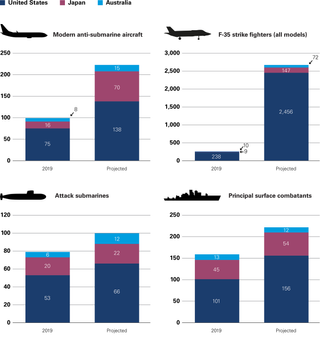
Submarines — both nuclear and conventional — will be critical capabilities for collective deterrence and denial. Notwithstanding the future introduction of unmanned underwater vehicles (UUVs), submarines are highly likely to remain valuable asymmetric assets in the Indo-Pacific, acting as force multipliers for small and middle powers like Australia due to their stealth, range and multi-role functions.357 Over the next several decades, both Japan and Australia are undertaking significant submarine modernisation programs, with Canberra set to double its attack submarine force from six to 12 boats with the arrival of the French-designed Attack-class boat and Tokyo commencing design work on the successor to its Soryu-class submarine.358 Both are planned to be non-nuclear powered, and while conventional submarines have drawbacks in terms of range and endurance, they are effective in monitoring and blockading chokepoints and littoral waters — precisely the kind of critical strategic geography that characterises the First Island Chain and Southeast Asian littoral.359 Future classes of allied submarines may also be able to assume additional mission sets, such as providing deception effects, countering China’s future UUVs, conducting electromagnetic warfare and aiding the suppression of Chinese counter-intervention assets through long-range strike.360
A consideration for Australia will be the need to account for the current projected decline of the US nuclear attack submarine fleet through the 2020s, which is predicted to reach a nadir of 42 boats by 2028.361 As the US defence industrial base is strained with simultaneous Columbia- and Virginia-class construction over the next decade, Australia and Japan should consider bringing forward submarine construction or extending the service lives of their own fleets.362 For Australia, options include accelerating construction of the Attack-class from 24 to 18 months per hull and producing two boats in parallel, potentially bringing forward the timeframe of delivery.363 Australia is already expected to extend the service life of five of the current Collins-class boats, ensuring a mixed fleet through the 2030s.364
Principal surface combatants present another opportunity for Australia and Japan to aggregate assets with the US military. Surface combatants — such as frigates, destroyers and amphibious assault vessels — can play a role in responding to fait accompli aggression in the Indo-Pacific. This is not currently the case. At present, many large but highly-capable surface combatants are still vulnerable to salvos of precision-guided anti-ship missiles, threatened by capable attack submarines, and ill-equipped for a strategy of sea-control against modern PLAN assets around the First and Second Island Chains.365 But while they lack the ability to “blunt” aggression, they bring important advantages in mobility, missile defence and multi-role mission sets — all of which can be applied to “surging” in response to a conflict.
One example of this future role for surface combatants in regional collective defence will be the formation of a mobile strategic reserve. Comprising maritime, air, cyber and strike forces, such a reserve would be “capable of deploying rapidly to threatened sectors” of the First Island Chain or beyond to counter any potential massing of PLA forces.366 It is likely that surface combatants will play important roles in this task by threatening advancing PLA forces from outside the range of China’s counter-intervention systems. The fact that Japan and Australia will have a combined total of 20 major surface combatants equipped with sophisticated Aegis missile defence systems will permit them to play a crucial warfighting role in degrading and blunting missile strikes against immobile allied targets.367 Major surface combatants from Australia and Japan could also play critical roles in facilitating and escorting coalition amphibious operations to reverse Chinese territorial gains, or providing missile defence for forces providing offensive operations.368
Australian and Japanese naval and maritime air forces can also make significant contributions to coalition strategic anti-submarine warfare operations. Large-scale, coordinated and networked ASW campaigns remain a critical area of asymmetric advantage for coalition forces in the Indo-Pacific.369 This is partly reflected in both Australia and Japan’s considerable ongoing investments in new fleets of next-generation ASW aircraft. Over the next decade, the Royal Australian Air Force (RAAF) will operate up to 15 P-8s, while the JMSDF will have 70 P-1s in its inventory. These capabilities could be called on to provide major contributions to coalition ASW operations in North or Southeast Asia, particularly as the US Navy’s planned fleet of 138 P-8s will have to satisfy America’s — potentially very large — global demand for ASW effects. Australia’s surface vessel recapitalisation is also adding sophisticated ASW capability to the entire feet, with nine new ASW frigates, towed-array sonars for the new destroyers and 24 MH-60 Romeo maritime helicopters.370 Taken together, these capabilities mean that Tokyo and Canberra will possess a genuinely credible capability to bring to bear in any major ASW campaign in the Indo-Pacific — finding, tracking and, if necessary, countering Chinese submarines as part of an overall defensive strategy of deterrence by denial.371
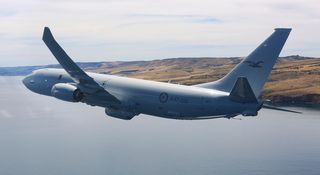
2. Reform US-Australia alliance coordination mechanisms
Coordination within the ANZUS alliance should also be focused on strengthening regional conventional deterrence. This will require: Identifying shared thresholds for action in advance of a crisis; deepening intelligence, operational and tactical planning; and working to bridge the divide among and between political and strategic communities in the United States and Australia. Crucially, neither the US-Australia alliance nor the broader regional alliance and partner network have developed the levels of military interoperability, shared understandings of risk and resolve, or coordination required for credible collective deterrence. Cohesion, while improving, is limited and will, if unaddressed, impede efforts to aggregate capabilities or execute a collective balancing strategy. Indeed, it is compounded at the political level by divergent threat perceptions about the nature and scale of the challenge China poses to US and Australian interests. Avoiding expectation gaps within ANZUS and with coalition partners like Japan is essential for undertaking effective operational planning for deterring plausible crisis scenarios. This requires shared understandings of different thresholds for military action and the development of a joint willingness to accept a degree of risk.372
At present, coordination within ANZUS is conducted at the ministerial-level through the annual AUSMIN dialogue in addition to a series of regular, high-level military and strategic engagements. Reform of defence and strategic policy coordination within the alliance, however, should be a priority as American security resources become more strained and collective regional responses to Chinese assertiveness grow more demanding. Although the alliance has recently become more focused on Indo-Pacific strategy, the US-Australia relationship has not been severely tested in this region by, for example, a major security crisis or the imperative for a significant joint military operation in Australia’s near region.373 Recent, early efforts towards bridging the political-strategic gap were evident in the 2018 AUSMIN joint work plan — which laid out specific areas for coordinating diplomatic, economic and military activities in the region — but need to be expanded on, particularly in terms of defence strategy.374
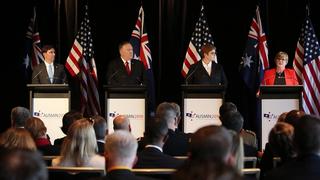
This will be a challenge. Bilateral defence engagement between the United States and Australia is crowded with multiple mechanisms, sometimes at the expense of focused outcomes. Effort must therefore be made to streamline and focus the existing fora that are most valuable to bolstering regional deterrence. Developing a joint and in-depth understanding of plausible regional scenarios, thresholds for kinetic action, strategic lines of effort, escalation risks and resourcing demands would add serious credibility to the alliance in contributing to collective action in the region. Strategic futures simulations should be incorporated into these consultations with the aim of developing systematic bilateral approaches to likely deterrence and conflict scenarios in the Indo-Pacific.375 By way of precedent, similar exercises were conducted between the United States and Japan during the Cold War, like the Global War Games held at the US Naval War College throughout the 1980s. Scenarios explored Tokyo’s participation in America’s Cold War-era Maritime Strategy, the strategic impact of a neutral Japan during a wider conflict, and other contingencies for planning and strategy development.376 Contemporary models that may be suitable for ANZUS in the short-term include the US-Norwegian Bilateral Study Group, rather than the more highly structured mechanisms that exist between the United States and Japan and the United States and South Korea.377
3. Rebalance Australian defence resources from the Middle East to the Indo-Pacific
Australia should strategically reprioritise forces and focus operational resources on the Indo-Pacific. This requires a major rebalancing away from the Middle East. At present, a significant portion of the Australian Defence Force (ADF) and its own finite resources remain entangled in ongoing operations in the Middle East, including counter-narcotics activities, capacity-building missions and supporting coalition air operations in the fight against ISIS. Australia, to be sure, has enduring interests in the Middle East — primarily in the security of sealanes through the Strait of Hormuz and Persian Gulf, a reality that is unlikely to change so long as Australia is dependent on unrefined fuels imported from the region.378 Yet, the nature of Australia’s military engagements in the Middle East must be considered in light of the significant opportunity costs they impose on ADF training, exercises and operations in support of collective security and deterrence in the Indo-Pacific, as well as the long-term attrition on personnel and equipment.
Military operations in Afghanistan and Iraq continue to consume a disproportionate share of Australia's defence operating budget, even as Chinese military presence in the Indo-Pacific grows in intensity and sophistication.
Military operations in Afghanistan and Iraq continue to consume a disproportionate share of the Australian Department of Defence’s operating budget, even as Chinese military presence in the Indo-Pacific grows in intensity and sophistication. Between 2001 and 2018, Australia spent a total of A$14.7 billion on operations in the Middle East compared to only A$3.9 billion for operations in the Indo-Pacific over the same period.379 In 2018 alone, Defence allocated A$813.5 million to the four ongoing ADF operations in the Middle East.380 Australia is the second largest contributor to the Afghan National Army Fund, having donated over A$700 million since 2010.381 High-end assets are deployed on an ongoing basis, with a KC-30A air-to-air refuelling tanker and an E-7A Wedgetail airborne battle management aircraft recently re-deployed until at least late 2020.382 Almost 600 ADF personnel are currently in the region to support Australia’s contribution to coalition efforts against ISIS under Operation Okra.
Although repeat deployments to the Middle East over the past two decades have afforded the ADF opportunities to gain real-world combat experience, this “conflict dividend” is of declining value today. Back in 2014, the deployment of a RAAF combat group of F/A-18s, a KC-30A refuelling aircraft and AWACS Wedgetail to Iraq was a “defining moment” for Australia, marking the first time a full air combat package was deployed over such a significant distance in a short timeframe.383 The use of the Wedgetail in particular — a key battle management capability that enables coordination among large numbers of coalition fighter aircraft and aerial refuelling assets — was an instructive and relevant operational experience. But there are limits to the applicability of experience gained in the Middle East to future coalition operations in the Indo-Pacific. For instance, the aerial environment in Iraq and Syria is largely permissive — quite unlike the contested skies of the Western Pacific — enabling a focus on low tempo sorties and limited strike operations rather than high-tempo air-to-air combat. Not only are such operations of little value in preparing for major power conflict, but honing these skills also risks the atrophy of “pure fighter skills” over time.384
Attrition of assets has been an additional drawback. During sustained operations in the Middle East, Australian F/A-18s were being flown up to four times the peacetime rate and, at the end of three years, had collectively chalked up 21,000 flying hours.385 Similarly high rates of use for the Wedgetail and KC-30A refuelling aircraft have been reported.386 All of this adds to the wear and tear on expensive assets, requiring greater resources for operations and maintenance in return for questionable strategic payoffs for Australia.
Beyond the training and strike missions conducted by the Army and RAAF, the Royal Australian Navy has maintained a frigate on near-constant patrol in Middle Eastern waters for decades. In the latest rotation, Anzac-class frigate HMAS Ballarat departed Australian waters in October 2018 for a nine-month deployment, the 67th rotation of a RAN warship since 1990.387 Although the patrols have been highly successful in countering drug smuggling in the region, maintaining a frigate on station in the Middle East has tied-up a third of Australia’s surface fleet for much of this time owing to the need for one vessel to be in maintenance and another in training in order to maintain one permanently at sea.388 As a favourable Indo-Pacific balance of power becomes increasingly difficult to sustain, Canberra’s dedication of such a large portion of its surface fleet to the Middle East does not make strategic sense.389 Funding for these and similar global engagements should be repurposed to operationalise tailored deterrence initiatives in the Indo-Pacific, such as training missions, rotational naval deployments or high-end warfighting exercises in the Western Pacific, Indian Ocean, Pacific and Southeast Asian littoral. These should be conducted independently by Australia and jointly with allies and partners to advance collective defence objectives.
4. Establish new, and expand existing, high-end military exercises
Australia conducts and participates in a range of sophisticated military exercises, including Talisman Sabre and Exercise Pitch Black. Talisman Sabre is the main combined military exercise between Australia and the United States — held every two years — focusing on high-intensity warfare and involving amphibious, logistics, air and land operations.390 For the first time in 2019, the exercise was expanded to include the Japanese Amphibious Rapid Deployment Brigade, reflecting the growing multi-national aspect of the exercise as well as its large amphibious operations component. Such collective capabilities and habits of defence cooperation will be critical for deterring and responding to prospective Chinese aggression.391 Similarly, Exercise Pitch Black is a biennial multi-national air power exercise with participation from the United States, Canada, Germany, Indonesia, Singapore, Thailand, India and Malaysia, allowing Australia to utilise its large northern air training zones to further enhance regional military interoperability.392
The primary aim of high-end exercises should be to bolster the collective ability to deter, deny and, if necessary, blunt potential Chinese aggression.
Repurposed operational funding from an Australian Middle East drawdown should be used to further grow these activities and establish new, joint and independent exercises tailored towards developing and demonstrating new operational concepts for Indo-Pacific contingencies. The primary aim of such exercises should be to bolster the collective ability to deter, deny and, if necessary, blunt potential Chinese fait accompli aggression. Specifically, exercises should practice and demonstrate rapid dispersal of air- and land-based strike forces from concentrated basing in mainland Japan, Okinawa and Guam, to small geographically diverse operating locations across the First and Second Island Chains.393 Exercises should also involve collective air base and surface action group defence in high-end and denied kinetic environments — including against advanced cyber capabilities and salvos of mixed long-range precision munitions.
Further, Australian and US forces should work towards demonstrating the logistical ability to rearm, refuel and redeploy geographically disperse forces, as well as transporting war-time relevant amounts of materiel and reserve forces from staging areas in Hawaii, the US west coast and continental Australia, across the Pacific and Southeast Asia, to forward locations on short notice. These exercises should begin to incorporate deception, cover, bluffing and surprise tactics in the movement and operation of naval, amphibious, air and land forces over significant distances in the Indo-Pacific, including through information activities, electromagnetic warfare and physical decoys, aided by special operations forces.394 Initial steps towards these aims could include joint scoping and planning between relevant US, Australian and possibly other military commands on the operational and sustainment needs for forward dispersed forces.
5. Acquire robust land-based strike and denial capabilities
Contributing to a denial strategy along the First and Second Island Chains will require force structure changes within the ADF. The most immediate and significant may be the need for advanced land-based sea and air denial capabilities and potentially long-range offensive strike systems. For the past several years, the Australian Army has been considering its role in collective anti-access and area denial operations, notably with publication of its Joint Archipelagic Manoeuvre concept in 2014.395 The concept draws upon advances in “land-based long-range precision-strike systems;... littoral anti-ship capabilities; air defence capabilities; long-range artillery and rocket systems” as opportunities for land forces to support air and maritime assets by assisting with sea-control and area denial — freeing up fighter aircraft and ships for offensive tasks “where their capabilities are optimised”.396

The 2016 Australian Defence White Paper hinted at these capabilities, forecasting that the government would acquire land-based anti-ship missiles at some point in the future.397 These systems could be a force multiplier for the ADF, allowing Australia to contribute to emerging American and partner operational concepts and establish an independent forward defence in depth to the region if needed.398 While there are operationally attractive reasons for the ADF to pursue land-based strike systems — both to contribute to coalition operations and to provide Australia with independent strategic effects — such a decision could trigger negative military and diplomatic consequences in Australia’s immediate vicinity.399 Robust diplomatic, political and military consultations with near neighbours, particularly Indonesia, should be conducted before Canberra embarks on establishing a long-range land-based offensive strike capability.
6. Improve regional posture, infrastructure and networked logistics
Continuing to strengthen Australia’s northern posture, infrastructure and ability to host integrated logistics networks are important contributions Canberra can make to regional deterrence. Australia’s geographic location has been described as the “Goldilocks zone” in the context of a major conflict in the Indo-Pacific: Close enough to act as a regional staging post and logistics node for allied and partner forces, but far enough away from China to make it relatively difficult for the PLA to launch concentrated kinetic strikes on military facilities.400 Crucially, Australian defence facilities and force posture initiatives could have direct and indirect impacts on the outcome of contingencies in the First and Second Island Chains, particularly insofar as they would enable regional forces to project power into the strategically vital Lombok and Sunda Straits which may act as transit points for PLA-N submarines.401
Australia’s geographic location has been described as the “Goldilocks zone”: Close enough to act as a regional staging post and logistics node for allied and partner forces, but far enough away from China to make it relatively difficult for the PLA to launch concentrated kinetic strikes on military facilities.
The high costs associated with building and sustaining new infrastructure, supply stores and forward-deployed assets in northern Australia and Australia’s offshore territories has been a barrier to implementing and expanding ADF, American and partner force posture. Work is beginning on facility upgrades outlined in the 2016 Defence White Paper and US force posture initiative, such as airfield upgrades on Cocos Island to support P-8 ASW patrols and the expansion of aviation fuel and munitions storage at RAAF Bases in Darwin and Tindal.402 But additional resourcing of infrastructure linked to specific initiatives — such as the US-Australia Enhanced Air Cooperation agreement — is warranted in light of the growing need for safe forward-basing of allied equipment and new locations for rapid dispersal and operation of combat aircraft.403 Additionally, further advancements to Australia’s JORN over-the-horizon radar network infrastructure, including the potential placement of sites in northern Australia, could provide valuable intelligence, targeting and missile defence information for dispersed allied and partner air- and land-based strike forces in the region.404
The United States and Australia should also urgently review the logistical impact of their declining merchant fleets on the credibility of their conventional deterrence threats. Nationally flagged vessels that run on a commercial basis can be requisitioned during a crisis and would be critical in moving large quantities of fuel and materiel through alternative sea lanes if key routes and chokepoints throughout the Indo-Pacific were contested or closed.405 Due to the lengthy steaming times from North America and Hawaii to strategically important locations in North and Southeast Asia, maintaining a healthy merchant fleet and redundant logistical network would ensure regional allies and partners, like Japan, South Korea, Taiwan and others have options and resiliency in a crisis.406 The number of Australian and American-flagged vessels has declined over the past several decades due to stiff international competition in merchant shipping. With Australia’s merchant fleet falling from more than 100 vessels to 13 over the past 30 years, the Australian Labor Party has proposed establishing a “strategic shipping fleet” which should be stood up.407 More broadly, collective efforts towards ensuring adequate merchant fleets represent an area of potential collaboration between like-minded partners in the region and beyond.
7. Increase munition and fuel stockpiles
Australia should increase its stockpiles and create sovereign capability in the storage and production of precision munitions, fuel and other materiel necessary for sustained high-end conflict. Current stockpiles of critical munitions are alarmingly “based on minimal levels strongly influenced by peacetime training rates”.408 These are highly unlikely to be sufficient for even a minimal Australian involvement in a high-end deterrence or warfighting campaign in Northeast Asia. Australia’s munitions inventory is based on the assumption that the ADF could draw on US supplies in the event of a joint or independent campaign.409 But American supplies and production are already strained and any major campaign in the region would see US and Australian demand “spike simultaneously”, leaving Australia and other allies potentially without the ability to “influence the conduct of operations in our own backyard”.410 Comprehensive planning for major mobilisation, including identifying the munitions stocks and shortfalls that Australia would require to sustain its regional interests during a conflict, should be conducted in the near-term.
The large number of munitions that would be used during a major power conflict in the region demands resiliency in ADF and US stockpiles, but also raises a potential need for domestic production.411 Australia’s sovereign munition-vulnerability rests not with the production of explosives and other inputs, but with the “smart” aspects of modern munitions that enable their networking, guidance and durability. Considering Australia’s likely significant maritime contribution to any collective response to a Chinese fait accompli, Canberra should seek to replicate and expand its sovereign production of sonobuoys and small-arms munitions to cover other capabilities like the Mark 48 and Mark 46 torpedo, Harpoon anti-ship missiles and sea mines. One option could be a networked approach to production, where Australia, Japan and other regional partners host domestic munitions manufacturing facilities with the United States receiving royalties and access to the production chain.412
Australia’s inadequate fuel stockpiles should also be increased, a policy with emerging bipartisan support.413 Despite International Energy Association (IEA) obligations to store 90 days’ of fuel in reserve, Australia only holds 23 days of aviation fuel, 22 days of diesel and 19 days of automotive gas.414 This threatens the ability of the Australian military to function, to say nothing of national resiliency as a whole. In a crisis, logistical supply and sea lines of communication to US bases in the Western Pacific, and between continental United States and Australia, would not be guaranteed.415 With the ADF relying on a single supplier for fuel, Australia’s domestic crude refining capacity on the decline, and the bulk of refined fuel supplies now imported from Singapore — which is a 14-day journey from Australia — strategic fuel reserves must be increased to the IEA levels at a minimum.416 Near-term options include using decommissioned Australian refineries that retain unused storage capacity or installing additional tanks at import terminals.417
8. Establish an Indo-Pacific Security Workshop to drive US-allied joint operational concept development
The development of new operational concepts will be essential to maintaining conventional deterrence in the Indo-Pacific. At present, American and allied forces are structured and deployed to operate on the basis of outdated assumptions about air superiority, concentrated basing and long logistical lead-times. These will not hold against China’s modern military and ability to conduct a fait accompli strategy. New concepts, particularly in a joint environment, must be developed to address the specific operational challenges that the United States, Australia, Japan and other like-minded partners face in the Indo-Pacific. The establishment of an Indo-Pacific Security Workshop — based on the Cold War-era European-American Workshop that helped drive such concepts as Assault Breaker — is necessary to generate new ideas on technologies, capabilities and how they can be employed.418 Topic areas should include how human-machine teaming, stand-off capabilities and offensive strike can be utilised against a “technically advanced, numerically superior enemy”.419 Such a workshop would also be useful in building and maintaining shared analytic capabilities across the strategic policy workforces of Australia, the United States, Japan and other partners.420
9. Advance joint experimental research and development projects aimed at improving the cost-capability curve
In line with developing new operational concepts, Australia, the United States, Japan and other partners should stand up joint research and development programs on technologies and capabilities focused on lowering the cost-capability curve. Next-generation military platforms and capabilities are growing in cost and complexity at an exponential rate across many allied militaries. In a future of flatlining US defence budgets in real terms, and given the ineffectiveness of the “American war of war” in an era of great power competition, developing new types of platforms and technologies to improve the buying power of defence acquisition is essential.421 Indeed, joint development and research of emerging capabilities among close allies and partners is likely to become a requirement for ensuring an enduring conventional military edge. This is due to that fact that China’s sustained and heavy investment in national research and development activities is, in purchasing power parity terms, already nearing equivalence with America — and not far behind the Five Eyes group as a whole, comprising the United States, United Kingdom, Canada, Australia and New Zealand. Taking advantage of the integration afforded under recent changes to the US National Technology Industrial Base and reforming arrangements like the International Traffic in Arms Regulations will be key to enabling long-term and sustainable research and development projects.422
Figure 15: Trends in national research and development

Current examples of programs addressing the cost-capability curve include the Strategic Capability Office’s Avatar project and the experimental low-cost XQ-58A Valkyrie, both of which are aimed at developing low-cost, autonomous, human-machine team platforms.423 A similar effort is underway between the RAAF and Boeing with the Air Power Teaming System.424 These complementary programs are intended to field low-cost autonomous “wingmen” that can be teamed or operate independently with manned combat aircraft, providing greater missile payloads, electromagnetic decoys or intelligence capacity.425 Importantly, these emerging capabilities could allow smaller air forces like the RAAF to supplement expensive and advanced fifth-generation stealth fighters with low-cost but useful UAVs, beefing up their mass against the larger number of air assets that the PLA can field. Complementary programs focusing on land-based strike and maritime capabilities should be areas of sustained and focused development between the United States, Australia and other Five Eye partners, as well as Japan, as new operational concepts are established.
